Argumentative Essay Writing
Argumentative Essay About Climate Change


Make Your Case: A Guide to Writing an Argumentative Essay on Climate Change
Published on: Mar 2, 2023
Last updated on: Jan 31, 2024
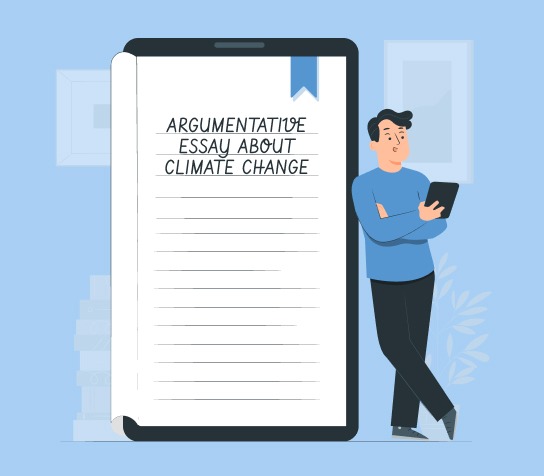
People also read
Argumentative Essay - A Complete Writing Guide
Learn How to Write an Argumentative Essay Outline
Best Argumentative Essay Examples for Your Help
Basic Types of Argument and How to Use Them?
Take Your Pick – 200+ Argumentative Essay Topics
Essential Tips and Examples for Writing an Engaging Argumentative Essay about Abortion
Crafting a Winning Argumentative Essay on Social Media
Craft a Winning Argumentative Essay about Mental Health
Strategies for Writing a Winning Argumentative Essay about Technology
Crafting an Unbeatable Argumentative Essay About Gun Control
Win the Debate - Writing An Effective Argumentative Essay About Sports
Ready, Set, Argue: Craft a Convincing Argumentative Essay About Wearing Mask
Crafting a Powerful Argumentative Essay about Global Warming: A Step-by-Step Guide
Share this article
With the issue of climate change making headlines, it’s no surprise that this has become one of the most debated topics in recent years.
But what does it really take to craft an effective argumentative essay about climate change?
Writing an argumentative essay requires a student to thoroughly research and articulate their own opinion on a specific topic.
To write such an essay, you will need to be well-informed regarding global warming. By doing so, your arguments may stand firm backed by both evidence and logic.
In this blog, we will discuss some tips for crafting a factually reliable argumentative essay about climate change!
On This Page On This Page -->
What is an Argumentative Essay about Climate Change?
The main focus will be on trying to prove that global warming is caused by human activities. Your goal should be to convince your readers that human activity is causing climate change.
To achieve this, you will need to use a variety of research methods to collect data on the topic. You need to make an argument as to why climate change needs to be taken more seriously.
Argumentative Essay Outline about Climate Change
An argumentative essay about climate change requires a student to take an opinionated stance on the subject.
The outline of your paper should include the following sections:
Argumentative Essay About Climate Change Introduction
The first step is to introduce the topic and provide an overview of the main points you will cover in the essay.
This should include a brief description of what climate change is. Furthermore, it should include current research on how humans are contributing to global warming.
An example is:

Paper Due? Why Suffer? That's our Job!
Thesis Statement For Climate Change Argumentative Essay
The thesis statement should be a clear and concise description of your opinion on the topic. It should be established early in the essay and reiterated throughout.
For example, an argumentative essay about climate change could have a thesis statement such as:
Climate Change Argumentative Essay Conclusion
The conclusion should restate your thesis statement and summarize the main points of the essay.
It should also provide a call to action, encouraging readers to take steps toward addressing climate change.
For example,
How To Write An Argumentative Essay On Climate Change
Writing an argumentative essay about climate change requires a student to take an opinionated stance on the subject.
Following are the steps to follow for writing an argumentative essay about climate change
Do Your Research
The first step is researching the topic and collecting evidence to back up your argument.
You should look at scientific research, articles, and data on climate change as well as current policy solutions.
Pick A Catchy Title
Once you have gathered your evidence, it is time to pick a title for your essay. It should be specific and concise.
Outline Your Essay
After selecting a title, create an outline of the main points you will include in the essay.
This should include an introduction, body paragraphs that provide evidence for your argument, and a conclusion.
Compose Your Essay
Finally, begin writing your essay. Start with an introduction that provides a brief overview of the main points you will cover and includes your thesis statement.
Then move on to the body paragraphs, providing evidence to back up your argument.
Finally, conclude the essay by restating your thesis statement and summarizing the main points.
Proofread and Revise
Once you have finished writing the essay, it is important to proofread and revise your work.
Check for any spelling or grammatical errors, and make sure the argument is clear and logical.
Finally, consider having someone else read over the essay for a fresh perspective.
By following these steps, you can create an effective argumentative essay on climate change. Good luck!
Examples Of Argumentative Essays About Climate Change
Climate Change is real and happening right now. It is one of the most urgent environmental issues that we face today.
Argumentative essays about this topic can help raise awareness that we need to protect our planet.
Below you will find some examples of argumentative essays on climate change written by CollegeEssay.orgâs expert essay writers.
Argumentative Essay About Climate Change And Global Warming
Persuasive Essay About Climate Change
Argumentative Essay About Climate Change In The Philippines
Argumentative Essay About Climate Change Caused By Humans
Geography Argumentative Essay About Climate Change
Check our extensive blog on argumentative essay examples to ace your next essay!
Good Argumentative Essay Topics About Climate Change
Choosing a great topic is essential to help your readers understand and engage with the issue.
Here are some suggestions:
- Should governments fund projects that will reduce the effects of climate change?
- Is it too late to stop global warming and climate change?
- Are international treaties effective in reducing carbon dioxide emissions?
- What are the economic implications of climate change?
- Should renewable energy be mandated as a priority over traditional fossil fuels?
- How can individuals help reduce their carbon footprint and fight climate change?
- Are regulations on industry enough to reduce global warming and climate change?
- Could geoengineering be used to mitigate climate change?
- What are the social and political effects of global warming and climate change?
- Should companies be held accountable for their contribution to climate change?
Check our comprehensive blog on argumentative essay topics to get more topic ideas!
We hope these topics and resources help you write a great argumentative essay about climate change.
Now that you know how to write an argumentative essay about climate change, itâs time to put your skills to the test.
Overwhelmed with assignments and thinking, "I wish someone could write me an essay "?
Our specialized writing service is here to turn that wish into reality. With a focus on quality, originality, and timely delivery, our team of professionals is committed to crafting essays that align perfectly with your academic goals.
And for those seeking an extra edge, our essay writer , an advanced AI tool, is ready to elevate your writing to new heights.
Frequently Asked Questions
What is a good introduction to climate change.
An introduction to a climate change essay can include a short description of why the topic is important and/or relevant.
It can also provide an overview of what will be discussed in the body of the essay.
The introduction should conclude with a clear, focused thesis statement that outlines the main argument in your essay.
What is a good thesis statement for climate change?
A good thesis statement for a climate change essay should state the main point or argument you will make in your essay.
You could argue that “The science behind climate change is irrefutable and must be addressed by governments, businesses, and individuals.”
Cathy A. (Medical school essay, Education)
For more than five years now, Cathy has been one of our most hardworking authors on the platform. With a Masters degree in mass communication, she knows the ins and outs of professional writing. Clients often leave her glowing reviews for being an amazing writer who takes her work very seriously.
Paper Due? Why Suffer? That’s our Job!

Keep reading

Legal & Policies
- Privacy Policy
- Cookies Policy
- Terms of Use
- Refunds & Cancellations
- Our Writers
- Success Stories
- Our Guarantees
- Affiliate Program
- Referral Program
- AI Essay Writer
Disclaimer: All client orders are completed by our team of highly qualified human writers. The essays and papers provided by us are not to be used for submission but rather as learning models only.
view all topics > Climate change
Humans are causing global warming
The climate is changing — the thing is, it isn’t just due to humans.
Natural forces beyond human control are also gradually affecting our climate. These geophysical forces are vital to understanding global warming. Man is indeed responsible for a large portion — possibly even a majority — of global warming. But also in play are complex gravitational interactions, including changes in the Earth’s orbit, axial tilt and torque.
This fact needs to be included in the public debate. Because these gravitational shifts, occurring over millennia, can influence climate patterns and ultimately lead to noticeable variations in seasons. Interestingly, research suggests climate change can alter the tilt of the Earth, but an unrelated change in tilt can also further change the climate. It is a balance-counterbalance relationship.
Changes in the Earth’s path around the Sun, or eccentricity, involve shifts in the orbit around the Sun from a roughly circular journey to more of an elliptical one . When the Earth gradually adopts a more elliptical orbit, there are more pronounced temperatures during the summer and winter months. This alteration is exacerbated when the Earth’s axial tilt is inclined to a sharper degree than usual. As this happens, it causes the North and South Poles to be positioned more directly toward the Sun.
Haven’t you noticed the recent rise in irregular weather patterns? This is not just a man-made problem. Gradual slight variations in the Earth’s orbit around the Sun can strongly influence temperature extremes. This is important because the conversation around climate change has become so politicized, we've totally lost sight of the science — and with it, any room for bipartisanship.

Tropical storms, for example, have been forming later in what we know as hurricane season. Based on my own analysis, over the past three decades, the majority of Category 3 or stronger storms to hit the United States appear from late August to early October. Earlier in the 20th century, storms usually occurred in June, July and early August.
It doesn’t stop there. Changes in seasons can also affect other types of storms, including severe winter snowstorms and tornadoes. Recall the Storm of the Century in 1993 on the heels of Hurricane Andrew the year prior. Or what about the recent string of snowstorms (with names like Snowpocalypse, Snowmageddon and Snowzilla) dovetailing with warm-weather superstorms. Climate extremes are evident, and not just with hurricanes.
The variations in the Earth’s orbit are known as the Milankovitch cycles — after the Serbian geophysicist Milutin Milanković, who hypothesized this phenomenon in the 1920s. He discovered that variations in the Earth’s path around the Sun, axial tilt and torque could together affect our climate.
Even a slight change or orientation in the precession of the Earth’s rotating body can cause a wobbling effect shifting torque in different areas since the planet is not a perfect sphere to some people’s surprise.
Now would seem a particularly apt time to act. The 2017 Atlantic hurricane season was an intense, record-setting period . With several landfall hurricanes — Harvey, Irma, Jose and Maria — barreling their way through the Caribbean and Gulf of Mexico, devastating parts of the Leeward Islands and United States.
Still, even President Donald J. Trump has implied the whole of idea climate change may just be a hoax . Most Republicans seem to agree that it is not a serious problem.
Meanwhile, while some Democrats have tried to use the frequency and intensity of storms in the hopes of highlighting the climate change conversation, even this effort has seemed muted.
To make effective policy, it is important for politicians and activists alike to set aside their ideological differences.
There is now a real opportunity for new legislation, sound environmental legislation. But will we squander this unprecedented opportunity, punting the ball yet again? You can bet on it. Given the realities of everyday life, the extent of social beliefs, political attitudes and economic perspectives vary on a wide range of policy issues.
To make sound and effective policy, it is important for politicians and activists alike to set aside their ideological differences and return to the basics of science, in this case, the mechanics of science. After all, shouldn’t we be relying more heavily upon geoscientists and weather forecasters to provide evidence-based data and predictive modeling?
Risks to disasters are increasing. Population growth along coastlines worldwide, in addition to technological and infrastructural development, will inherently result in a concomitant increase in places prone to disasters. Modern society relies upon government for effective response to and recovery from such events.
Change is occurring and will continue to do so. As the population continues to explode and resources are consumed on a massive scale, trying to stop both is unrealistic. It is more than just being unrealistic, it is simply wasting critical time. I know, science isn’t sexy. The obsession on why storms are occurring in lieu of discussing the how is leading us down a dangerous path. A deadly path.
The heightened culture of disaster only feeds our attention on political banter and ideological semantics with no room for informed decision-making.
We get it, Mother Nature always wins. So, are we now faced with the sobering lesson that little can be done, and we should just throw in the towel? No, of course not. Though climate change is inevitable, we also need to have a healthy appreciation of the fact that climate shifts aren’t just limited to rapidly changing weather patterns.
Turning the corner into unexplored territory is always difficult. By having a broader sense of communal resiliency — social, political and economic standing — we can manage this unavoidable pendulum of climate extremes. With the recent sweeping of storms draining response efforts and budgetary resources, now is the time to set aside the theatrical shenanigans and engage in realpolitik.
Tonya T. Neaves is the director for the Centers on the Public Service at George Mason University’s Schar School of Policy and Government, where she also is a faculty member in its master of public administration program and coordinator for the Emergency Management and Homeland Security certificate.
Tonya T. Neaves is the director for the Centers on the Public Service at George Mason University’s Schar School of Policy and Government, where she also is a faculty member in its master of public administration program and coordinator for the Emergency Management and Homeland Security certificate.
Knowledge is power
Stay in the know about climate impacts and solutions. Subscribe to our weekly newsletter.
By clicking submit, you agree to share your email address with the site owner and Mailchimp to receive emails from the site owner. Use the unsubscribe link in those emails to opt out at any time.

Yale Climate Connections
Scientists agree: Climate change is real and caused by people

Share this:
- Click to share on Facebook (Opens in new window)
- Click to share on X (Opens in new window)

[Leer en español aquí]
The scientific consensus that climate change is happening and that it is human-caused is strong. Scientific investigation of global warming began in the 19th century , and by the early 2000s, this research began to coalesce into confidence about the reality, causes, and general range of adverse effects of global warming. This conclusion was drawn from studying air and ocean temperatures, the atmosphere’s composition, satellite records, ice cores, modeling, and more.
In 1988 the United Nations and World Meteorological Organization founded the Intergovernmental Panel on Climate Change, IPCC, to provide regular updates on the scientific evidence on global warming. In a 2013 report , the IPCC concluded that scientific evidence of warming is “unequivocal” and that the largest cause is an increase of carbon dioxide in the atmosphere as a result of humans burning fossil fuels. The IPCC continues to assess this science, periodically issuing new reports.
Climate change is real and caused by humans
The IPCC is not the only scientific group that has reached a clear consensus on the scientific evidence of human-caused global warming. As this NASA page points out, 200 global scientific organizations, 11 international science academies, and 18 American science associations have released statements in alignment with this consensus.

Amanda Staudt is the senior director for climate, atmospheric and polar sciences at the National Academies of Science, Engineering and Medicine, where she has worked since 2001. The Academies, she said, first began studying climate change in 1979, researching how much warming would likely happen if the amount of carbon dioxide concentrations in the atmosphere were doubled.
Four decades later, those findings have held up and have been strengthened based on scores of continued studies and analysis. “The remarkable thing about that study,” she said, “is that they basically got the right answer” from the start. This 1979 study by the National Research Council, Staudt said, led to investment in climate science in the U.S.

Though this consensus has been thoroughly established, scientific research and new findings continue. Staudt said countless attempted rebuttals of climate science findings have been researched and disproved.
“We did a lot of studies in that time period, looking at those questions,” she said, ”and one by one, putting them to bed and convincing ourselves over and over again, that humans were affecting climate, and that we could document that effect.”
At the National Academies, reaching consensus requires open sessions and dialogue with scientists and agreement from committees, which typically consist of 12-15 experts. Their draft reports go through peer review, and reviewers’ concerns are resolved before publication is approved. The goal is for the complex science of climate change to become as thoroughly researched and substantiated as possible.
“One of the things I think about scientists is that we’re all inherently skeptics at some level,” Staudt said. “That’s what drives us to science, that we have questions about the world around us. And we want to prove that for ourselves.”
Scientists consistently reaffirm evidence that climate change is happening
Climate scientists worldwide go through similar processes before their findings are published. And their research papers, too, show a strong consensus about global warming. As NASA states on its website , “Multiple studies published in peer-reviewed scientific journals show that 97 percent or more of actively publishing climate scientists agree: Climate-warming trends over the past century are extremely likely due to human activities.” (By sound practice, scientists resist saying science is for all times “certain” or that its findings are “final,” and the “extremely likely” language respects that practice.)
One of the studies about the consensus was led by John Cook, a fellow at the Climate Change Communication Research Hub at Monash University in Melbourne, Australia. Cook and colleagues reviewed nearly 12,000 scientific papers to examine how aligned published research is on major findings on climate change. That study found that 97 percent of scholarly papers that take a position on climate change do endorse the consensus. The papers that rejected the consensus position contained errors, according to subsequent research .
In reviewing the papers, Cook has said he and his colleagues found the consensus to have been so widely accepted by 2013 that many researchers by then no longer felt a need to mention or reaffirm it in their research papers.

Also see: Causes of global warming: How scientists know that humans are responsible
Samantha Harrington
Samantha Harrington, director of audience experience for Yale Climate Connections, is a journalist and graphic designer with a background in digital media and entrepreneurship. Sam is especially interested... More by Samantha Harrington
- Climate modelling
- Extreme weather
- Health and Security
- Temperature
- China energy
- Oil and gas
- Other technologies
- China Policy
- International policy
- Other national policy
- Rest of world policy
- UN climate talks
- Country profiles
- Guest posts
- Infographics
- Media analysis
- State of the climate
- Translations
- Daily Brief
- China Briefing
- Comments Policy
- Cookies Policy
- Global emissions
- Rest of world emissions
- UK emissions
- EU emissions
- Global South Climate Database
- Newsletters
- COP21 Paris
- COP22 Marrakech
- COP24 Katowice
- COP25 Madrid
- COP26 Glasgow
- COP27 Sharm el-Sheikh
- COP28 Dubai
- Privacy Policy
- Attribution
- Geoengineering
- Food and farming
- Plants and forests
- Marine life
- Ocean acidification
- Ocean warming
- Sea level rise
- Human security
- Public health
- Public opinion
- Risk and adaptation
- Science communication
- Carbon budgets
- Climate sensitivity
- GHGs and aerosols
- Global temperature
- Negative emissions
- Rest of world temperature
- Tipping points
- UK temperature
- Thank you for subscribing
Social Channels
Search archive.

Receive a Daily or Weekly summary of the most important articles direct to your inbox, just enter your email below. By entering your email address you agree for your data to be handled in accordance with our Privacy Policy .
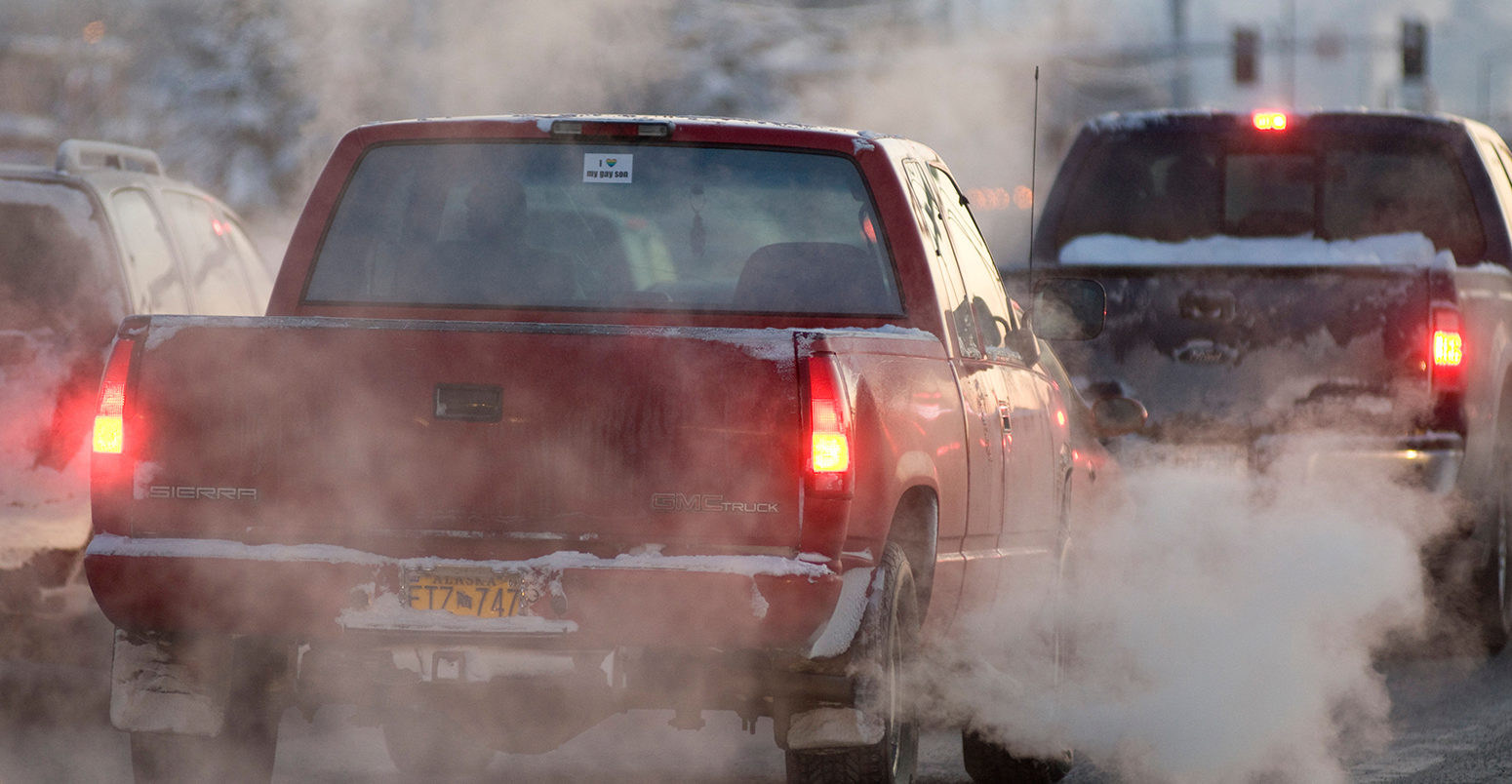
Analysis: Why scientists think 100% of global warming is due to humans

Zeke Hausfather
The extent of the human contribution to modern global warming is a hotly debated topic in political circles, particularly in the US.
During a recent congressional hearing, Rick Perry, the US energy secretary, remarked that “to stand up and say that 100% of global warming is because of human activity, I think on its face, is just indefensible”.
However, the science on the human contribution to modern warming is quite clear. Humans emissions and activities have caused around 100% of the warming observed since 1950, according to the Intergovernmental Panel on Climate Change’s (IPCC) fifth assessment report .
Here Carbon Brief examines how each of the major factors affecting the Earth’s climate would influence temperatures in isolation – and how their combined effects almost perfectly predict long-term changes in the global temperature.
Carbon Brief’s analysis finds that:
- Since 1850, almost all the long-term warming can be explained by greenhouse gas emissions and other human activities.
- If greenhouse gas emissions alone were warming the planet, we would expect to see about a third more warming than has actually occurred. They are offset by cooling from human-produced atmospheric aerosols.
- Aerosols are projected to decline significantly by 2100 , bringing total warming from all factors closer to warming from greenhouse gases alone.
- Natural variability in the Earth’s climate is unlikely to play a major role in long-term warming.
How much warming is caused by humans?
In its 2013 fifth assessment report, the IPCC stated in its summary for policymakers that it is “extremely likely that more than half of the observed increase in global average surface temperature” from 1951 to 2010 was caused by human activity. By “extremely likely”, it meant that there was between a 95% and 100% probability that more than half of modern warming was due to humans.
This somewhat convoluted statement has been often misinterpreted as implying that the human responsibility for modern warming lies somewhere between 50% and 100%. In fact, as NASA’s Dr Gavin Schmidt has pointed out, the IPCC’s implied best guess was that humans were responsible for around 110% of observed warming (ranging from 72% to 146%), with natural factors in isolation leading to a slight cooling over the past 50 years.
Similarly, the recent US fourth national climate assessment found that between 93% to 123% of observed 1951-2010 warming was due to human activities.
These conclusions have led to some confusion as to how more than 100% of observed warming could be attributable to human activity. A human contribution of greater than 100% is possible because natural climate change associated with volcanoes and solar activity would most likely have resulted in a slight cooling over the past 50 years, offsetting some of the warming associated with human activities.
‘Forcings’ that change the climate
Scientists measure the various factors that affect the amount of energy that reaches and remains in the Earth’s climate. They are known as “radiative forcings”.
These forcings include greenhouse gases, which trap outgoing heat, aerosols – both from human activities and volcanic eruptions – that reflect incoming sunlight and influence cloud formation, changes in solar output, changes in the reflectivity of the Earth’s surface associated with land use, and many other factors.
To assess the role of each different forcing in observed temperature changes, Carbon Brief adapted a simple statistical climate model developed by Dr Karsten Haustein and his colleagues at the University of Oxford and University of Leeds . This model finds the relationship between both human and natural climate forcings and temperature that best matches observed temperatures, both globally and over land areas only.
The figure below shows the estimated role of each different climate forcing in changing global surface temperatures since records began in 1850 – including greenhouse gases (red line), aerosols (dark blue), land use (light blue), ozone (pink), solar (yellow) and volcanoes (orange).
The black dots show observed temperatures from the Berkeley Earth surface temperature project, while the grey line shows the estimated warming from the combination of all the different types of forcings.
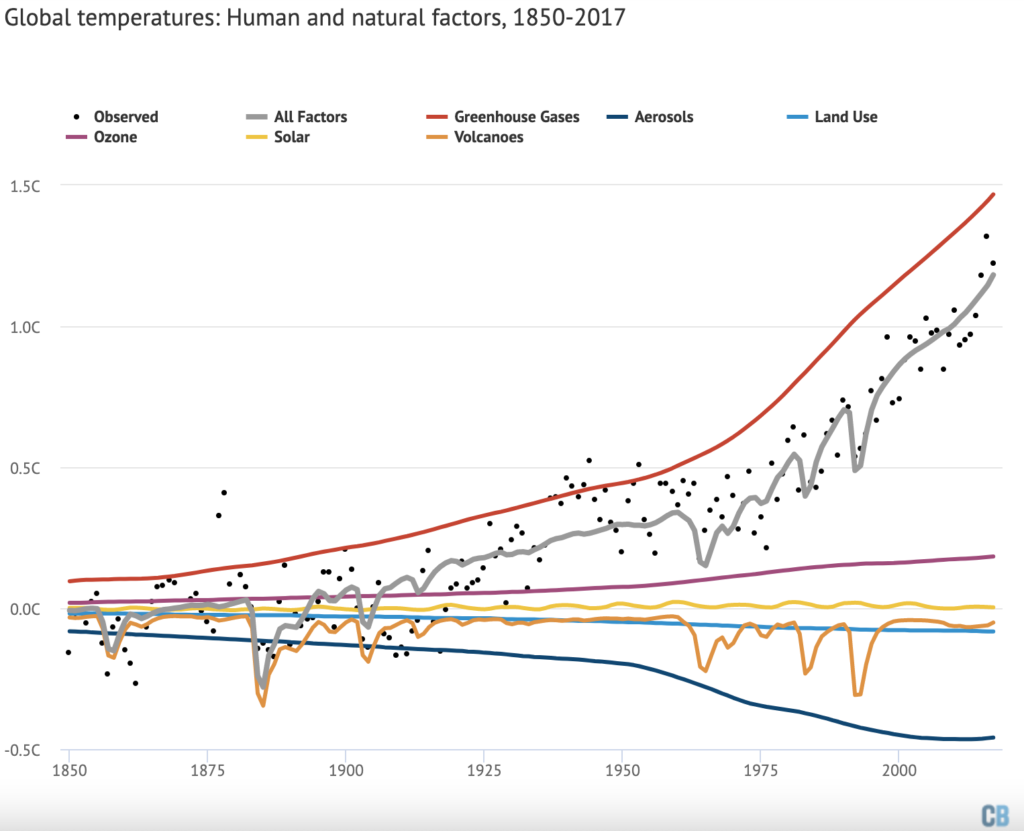
The combination of all radiative forcings generally matches longer-term changes in observed temperatures quite well. There is some year-to-year variability, primarily from El Niño events , that is not driven by changes in forcings. There are also periods from 1900-1920 and 1930-1950 where some larger disagreements are evident between projected and observed warming, both in this simple model and in more complex climate models .
The chart highlights that, of all the radiative forcings analysed, only increases in greenhouse gas emissions produce the magnitude of warming experienced over the past 150 years.
If greenhouse gas emissions alone were warming the planet, we would expect to see about a third more warming than has actually occurred.
So, what roles do all the other factors play?
- Q&A: How do climate models work?
- Interactive: The impacts of climate change at 1.5C, 2C and beyond
- Explainer: How scientists estimate ‘climate sensitivity’
- Mapped: How every part of the world has warmed – and could continue to warm
The extra warming from greenhouse gases is being offset by sulphur dioxide and other products of fossil fuel combustion that form atmospheric aerosols . Aerosols in the atmosphere both reflect incoming solar radiation back into space and increase the formation of high, reflective clouds, cooling the Earth.
Ozone is a short-lived greenhouse gas that traps outgoing heat and warms the Earth. Ozone is not emitted directly, but is formed when methane, carbon monoxide, nitrogen oxides and volatile organic compounds break down in the atmosphere. Increases in ozone are directly attributable to human emissions of these gases.
In the upper atmosphere, reductions in ozone associated with chlorofluorocarbons (CFCs) and other halocarbons depleting the ozone layer have had a modest cooling effect. The net effects of combined lower and upper atmospheric ozone changes have modestly warmed the Earth by a few tenths of a degree.
Changes in the way land is used alter the reflectivity of the Earth’s surface. For example, replacing a forest with a field will generally increase the amount of sunlight reflected back into space, particularly in snowy regions. The net climate effect of land-use changes since 1850 is a modest cooling.
Volcanoes have a short-term cooling effect on the climate due to their injection of sulphate aerosols high into the stratosphere, where they can remain aloft for a few years, reflecting incoming sunlight back into space. However, once the sulphates drift back down to the surface, the cooling effect of volcanoes goes away. The orange line shows the estimated impact of volcanoes on the climate, with large downward spikes in temperatures of up to 0.4C associated with major eruptions.

Finally, solar activity is measured by satellites over the past few decades and estimated based on sunspot counts in the more distant past. The amount of energy reaching the Earth from the sun fluctuates modestly on a cycle of around 11 years. There has been a slight increase in overall solar activity since the 1850s, but the amount of additional solar energy reaching the Earth is small compared to other radiative forcings examined.
Over the past 50 years, solar energy reaching the Earth has actually declined slightly , while temperatures have increased dramatically.
Human forcings match observed warming
The accuracy of this model depends on the accuracy of the radiative forcing estimates. Some types of radiative forcing like that from atmospheric CO2 concentrations can be directly measured and have relatively small uncertainties. Others, such as aerosols, are subject to much greater uncertainties due to the difficulty of accurately measuring their effects on cloud formation.
These are accounted for in the figure below, which shows combined natural forcings (blue line) and human forcings (red line) and the uncertainties that the statistical model associates with each. These shaded areas are based on 200 different estimates of radiative forcings, incorporating research attempting to estimate a range of values for each. Uncertainties in human factors increase after 1960, driven largely by increases in aerosol emissions after that point.
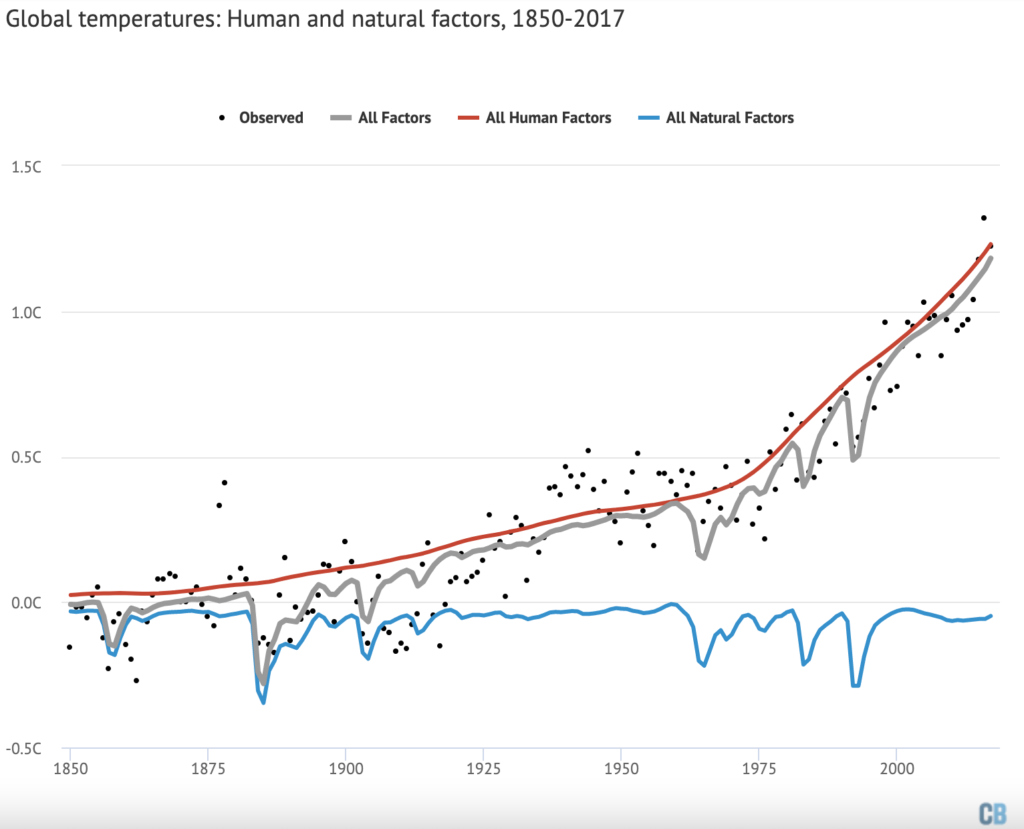
Overall, warming associated with all human forcings agrees quite well with observed warming, showing that about 104% of the total since the start of the “modern” period in 1950 comes from human activities (and 103% since 1850), which is similar to the value reported by the IPCC. Combined natural forcings show a modest cooling, primarily driven by volcanic eruptions.
The simple statistical model used for this analysis by Carbon Brief differs from much more complex climate models generally used by scientists to assess the human fingerprint on warming. Climate models do not simply “fit” forcings to observed temperatures. Climate models also include variations in temperature over space and time, and can account for different efficacies of radiative forcings in different regions of the Earth.
However, when analysing the impact of different forcings on global temperatures, complex climate models generally find results similar to simple statistical models. The figure below, from the IPCC’s Fifth Assessment Report, shows the influence of different factors on temperature for the period from 1950 to 2010. Observed temperatures are shown in black, while the sum of human forcings is shown in orange.
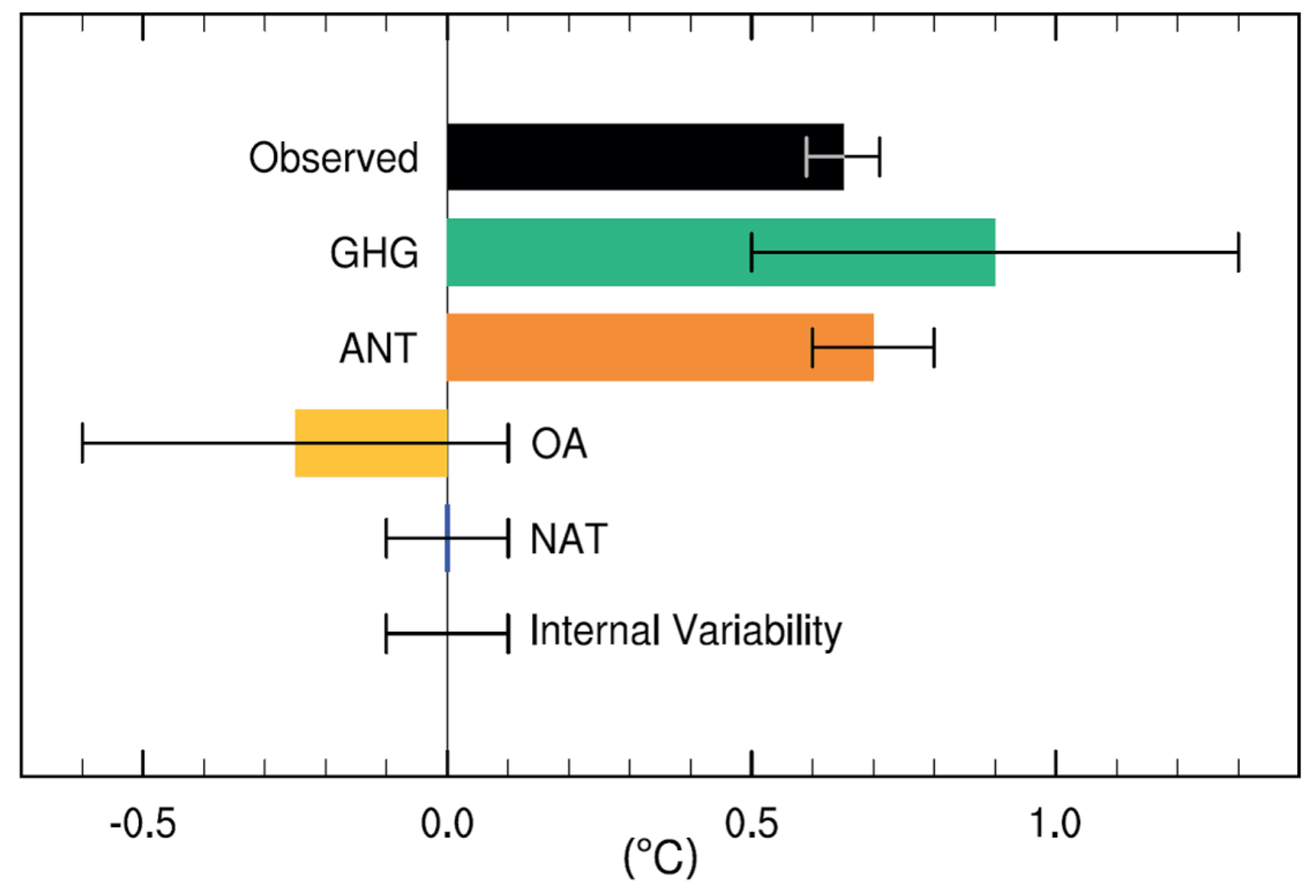
This suggests that human forcings alone would have resulted in approximately 110% of observed warming . The IPCC also included the estimated magnitude of internal variability over that period in the models, which they suggest is relatively small and comparable to that of natural forcings.
As Prof Gabi Hegerl at the University of Edinburgh tells Carbon Brief: “The IPCC report has an estimate that basically says the best guess is no contribution [from natural variability] with not that much uncertainty.”
Land areas are warming faster
Land temperatures have warmed considerably faster than average global temperatures over the past century, with temperatures reaching around 1.7C above pre-industrial levels in recent years. The land temperature record also goes back further in time than the global temperature record, though the period prior to 1850 is subject to much greater uncertainties .
Both human and natural radiative forcings can be matched to land temperatures using the statistical model. The magnitude of human and natural forcings will differ a bit between land and global temperatures. For example, volcanic eruptions appear to have a larger influence on land, as land temperatures are likely to respond faster to rapid changes in forcings.
The figure below shows the relative contribution of each different radiative forcing to land temperatures since 1750.
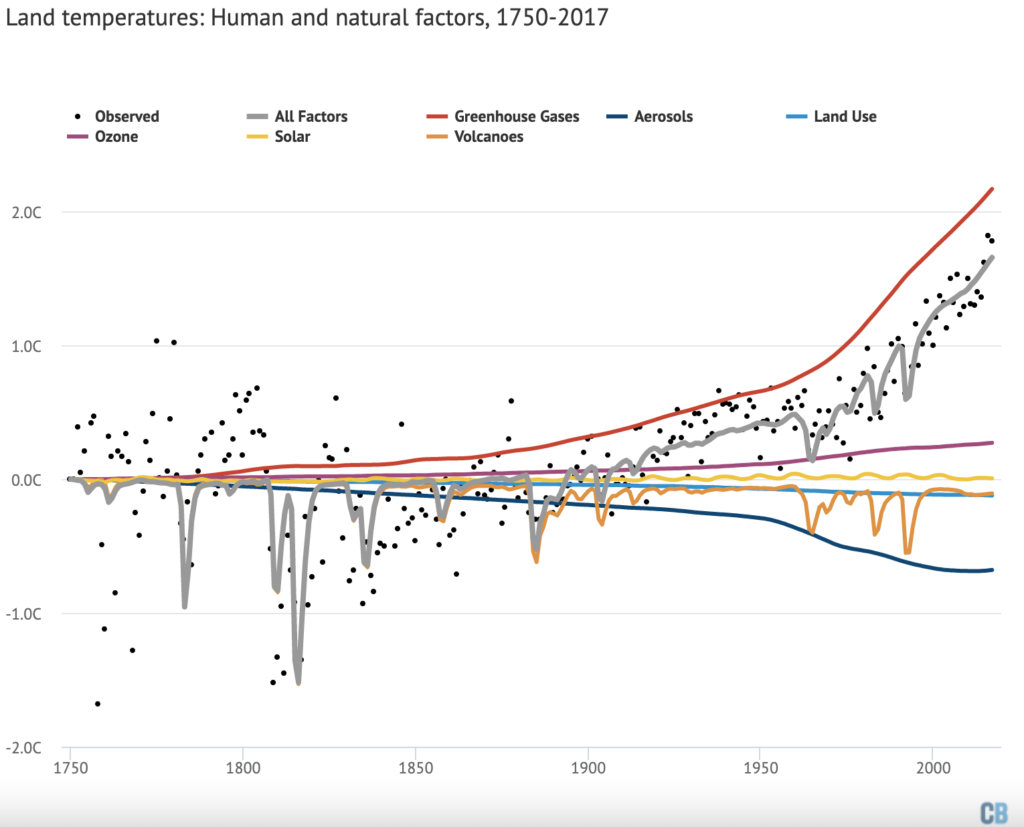
The combination of all forcings generally matches observed temperatures quite well, with short-term variability around the grey line primarily driven by El Niño and La Niña events. There is a wider variation in temperatures prior to 1850, reflecting the much larger uncertainties in the observational records that far back.
There is still a period around 1930 and 1940 where observations exceed what the model predicts, though the differences are less pronounced than in global temperatures and the 1900-1920 divergence is mostly absent in land records.
Volcanic eruptions in the late 1700s and early 1800s stand out sharply in the land record. The eruption of Mount Tambora in Indonesia in 1815 may have cooled land temperatures by a massive 1.5C, though records at the time were limited to parts of the Northern Hemisphere and it is, therefore, hard to draw a firm conclusion about global impacts. In general, volcanoes appear to cool land temperatures by nearly twice as much as global temperatures.
What may happen in the future?
Carbon Brief used the same model to project future temperature changes associated with each forcing factor. The figure below shows observations up to 2017, along with future post-2017 radiative forcings from RCP6.0 , a medium-to-high future warming scenario.
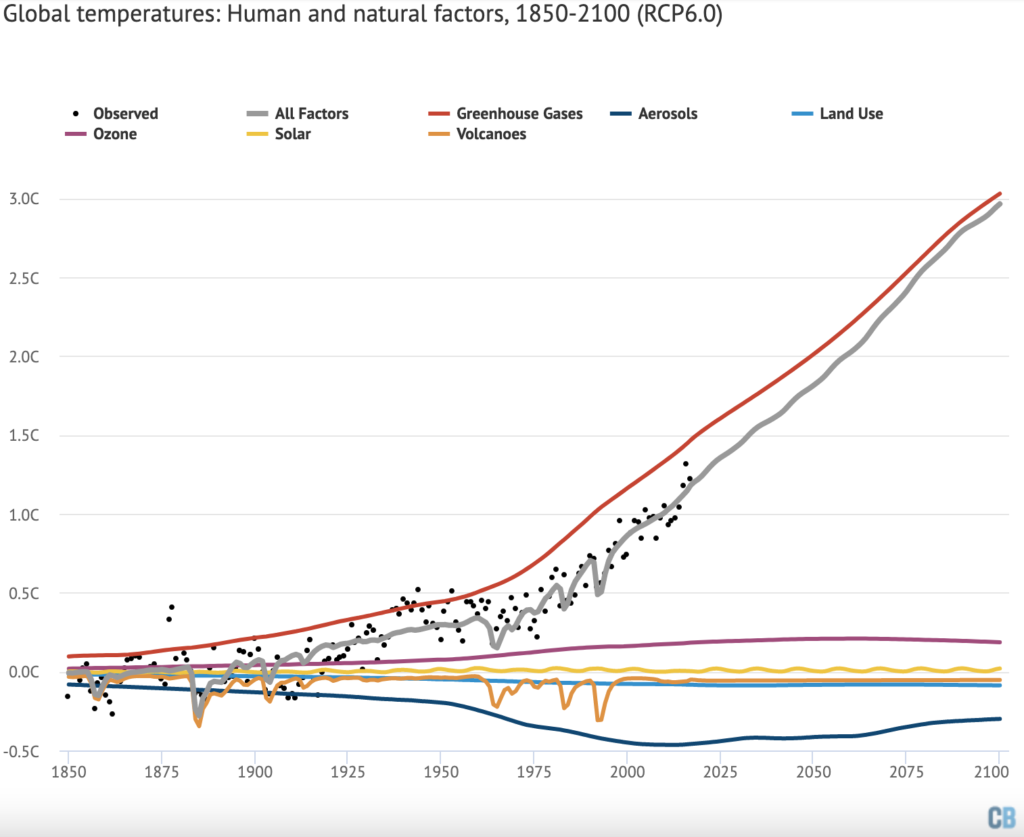
When provided with the radiative forcings for the RCP6.0 scenario, the simple statistical model shows warming of around 3C by 2100, nearly identical to the average warming that climate models find.
Future radiative forcing from CO2 is expected to continue to increase if emissions rise. Aerosols, on the other hand, are projected to peak at today’s levels and decline significantly by 2100 , driven in large part by concerns about air quality. This reduction in aerosols will enhance overall warming, bringing total warming from all radiative forcing closer to warming from greenhouse gases alone. The RCP scenarios assume no specific future volcanic eruptions, as the timing of these is unknowable, while solar output continues its 11-year cycle.
This approach can also be applied to land temperatures, as shown in the figure below. Here, land temperatures are shown between 1750 and 2100, with post-2017 forcings also from RCP6.0.
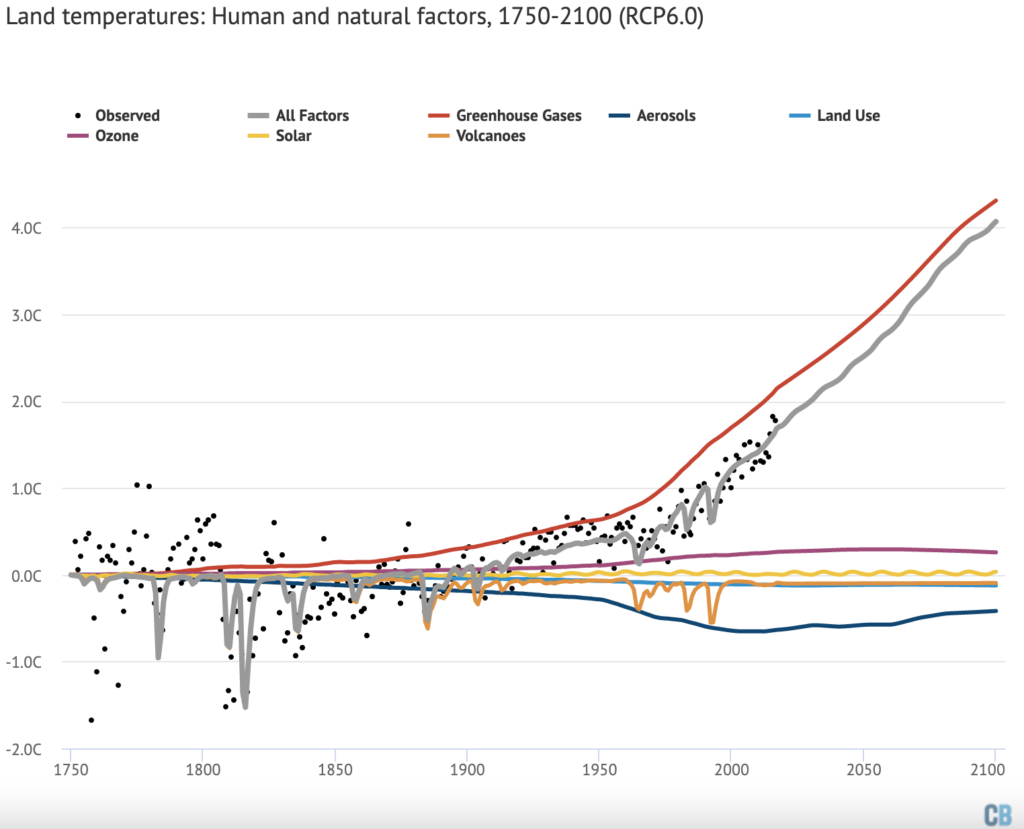
The land is expected to warm about 30% faster than the globe as a whole, as the rate of warming over the oceans is buffered by ocean heat uptake. This is seen in the model results, where land warms by around 4C by 2100 compared to 3C globally in the RCP6.0 scenario.
There is a wide range of future warming possible from different RCP scenarios and different values for the sensitivity of the climate system , but all show a similar pattern of declining future aerosol emissions and a larger role for greenhouse gas forcing in future temperatures.
The role of natural variability
While natural forcings from solar and volcanoes do not seem to play much of a role in long-term warming, there is also natural variability associated with ocean cycles and variations in ocean heat uptake.
As the vast majority of energy trapped by greenhouse gases is absorbed by the oceans rather than the atmosphere, changes in the rate of ocean heat uptake can potentially have large impacts on the surface temperature. Some researchers have argued that multidecadal cycles, such as the Atlantic Multidecadal Oscillation (AMO) and Pacific Decadal Oscillation (PDO), can play a role in warming at a decadal scale.
While human factors explain all the long-term warming, there are some specific periods that appear to have warmed or cooled faster than can be explained based on our best estimates of radiative forcing. For example, the modest mismatch between the radiative forcing-based estimate and observations during the mid-1900s might be evidence of a role for natural variability during that period.
A number of researchers have examined the potential for natural variability to impact long-term warming trends. They have found that it generally plays a limited role. For example, Dr Markus Huber and Dr Reto Knutti at the Institute for Atmospheric and Climate Science (IAC) in Zurich found a maximum possible contribution of natural variability of around 26% (+/- 12%) over the past 100 years and 18% (+/- 9%) over the past 50 years.
Knutti tells Carbon Brief:
“We can never completely rule out that natural variability is larger than we currently think. But that is a weak argument: you can, of course, never rule out the unknown unknown. The question is whether there is strong, or even any evidence for it. And the answer is no, in my view.
Models get the short-term temperature variability approximately right. In many cases, they even have too much. And for the long term, we can’t be sure because the observations are limited. But the forced response pretty much explains the observations, so there is no evidence from the 20th century that we are missing something…
Even if models were found to underestimate internal variability by a factor of three, it is extremely unlikely [less than 5% chance] that internal variability could produce a trend as large as observed.”
Similarly, Dr Martin Stolpe and colleagues, also at IAC, recently analysed the role of multidecadal natural variability in both the Atlantic and Pacific oceans. They found that “less than 10% of the observed global warming during the second half of the 20th century is caused by internal variability in these two ocean basins, reinforcing the attribution of most of the observed warming to anthropogenic forcings”.
Internal variability is likely to have a much larger role in regional temperatures. For example, in producing unusually warm periods in the Arctic and the US in the 1930s. However, its role in influencing long-term changes in global surface temperatures appears to be limited.
While there are natural factors that affect the Earth’s climate, the combined influence of volcanoes and changes in solar activity would have resulted in cooling rather than warming over the past 50 years.
The global warming witnessed over the past 150 years matches nearly perfectly what is expected from greenhouse gas emissions and other human activity, both in the simple model examined here and in more complex climate models. The best estimate of the human contribution to modern warming is around 100%.
Some uncertainty remains due to the role of natural variability, but researchers suggest that ocean fluctuations and similar factors are unlikely to be the cause of more than a small fraction of modern global warming.
Methodology
The simple statistical model used in this article is adapted from the Global Warming Index published by Haustein et al ( 2017 ). In turn, it is based on the Otto et al ( 2015 ) model.
The model estimates contributions to observed climate change and removes the impact of natural year-to-year fluctuations by a multiple linear regression of observed temperatures and estimated responses to total human-induced and total natural drivers of climate change. The forcing responses are provided by the standard simple climate model given in Chapter 8 of IPCC ( 2013 ), but the size of these responses is estimated by the fit to the observations. The forcings are based on IPCC (2013) values and were updated to 2017 using data from NOAA and ECLIPSE . 200 variations of these forcings were provided by Dr. Piers Forster of the University of Leeds , reflecting the uncertainty in forcing estimates. An Excel spreadsheet containing their model is also provided.
The model was adapted by calculating forcing responses for each of the different major climate forcings rather than simply total human and natural forcings, using the Berkeley Earth record for observations. The decay time of thermal response used in converting forcings to forcing responses was adjusted to be one year rather than four years for volcanic forcings to better reflect the fast response time present in observations. The effects of El Niño and La Niña (ENSO) events was removed from the observations using an approach adapted from Foster and Rahmstorf ( 2011 ) and the Kaplan El Niño 3.4 index when calculating the volcanic temperature response, as the overlap between volcanoes and ENSO otherwise complicates empirical estimates.
The temperature response for each individual forcing was calculated by scaling their forcing responses by the total human or natural coefficients from the regression model . The regression model was also run separately for land temperatures. Temperature responses for each forcing between 2018 and 2100 were estimated using forcing data from RCP6.0, normalised to match the magnitude of observed forcings at the end of 2017.
Uncertainties in total human and total natural temperature response was estimated using a Monte Carlo analysis of 200 different forcing series, as well as the uncertainties in the estimated regression coefficients. The Python code used to run the model is archived with GitHub and available for download .
Observational data from 2017 shown in the figures is based on the average of the first 10 months of the year and is likely to be quite similar to the ultimate annual value.
- Why scientists think 100% of global warming is due to humans
Expert analysis direct to your inbox.
Get a round-up of all the important articles and papers selected by Carbon Brief by email. Find out more about our newsletters here .
What Are the Causes of Climate Change?
We can’t fight climate change without understanding what drives it.
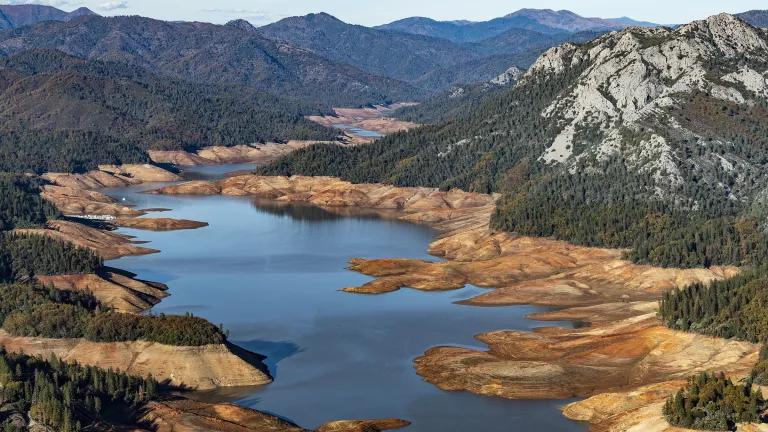
Low water levels at Shasta Lake, California, following a historic drought in October 2021
Andrew Innerarity/California Department of Water Resources

- Share this page block
At the root of climate change is the phenomenon known as the greenhouse effect , the term scientists use to describe the way that certain atmospheric gases “trap” heat that would otherwise radiate upward, from the planet’s surface, into outer space. On the one hand, we have the greenhouse effect to thank for the presence of life on earth; without it, our planet would be cold and unlivable.
But beginning in the mid- to late-19th century, human activity began pushing the greenhouse effect to new levels. The result? A planet that’s warmer right now than at any other point in human history, and getting ever warmer. This global warming has, in turn, dramatically altered natural cycles and weather patterns, with impacts that include extreme heat, protracted drought, increased flooding, more intense storms, and rising sea levels. Taken together, these miserable and sometimes deadly effects are what have come to be known as climate change .
Detailing and discussing the human causes of climate change isn’t about shaming people, or trying to make them feel guilty for their choices. It’s about defining the problem so that we can arrive at effective solutions. And we must honestly address its origins—even though it can sometimes be difficult, or even uncomfortable, to do so. Human civilization has made extraordinary productivity leaps, some of which have led to our currently overheated planet. But by harnessing that same ability to innovate and attaching it to a renewed sense of shared responsibility, we can find ways to cool the planet down, fight climate change , and chart a course toward a more just, equitable, and sustainable future.
Here’s a rough breakdown of the factors that are driving climate change.
Natural causes of climate change
Human-driven causes of climate change, transportation, electricity generation, industry & manufacturing, agriculture, oil & gas development, deforestation, our lifestyle choices.
Some amount of climate change can be attributed to natural phenomena. Over the course of Earth’s existence, volcanic eruptions , fluctuations in solar radiation , tectonic shifts , and even small changes in our orbit have all had observable effects on planetary warming and cooling patterns.
But climate records are able to show that today’s global warming—particularly what has occured since the start of the industrial revolution—is happening much, much faster than ever before. According to NASA , “[t]hese natural causes are still in play today, but their influence is too small or they occur too slowly to explain the rapid warming seen in recent decades.” And the records refute the misinformation that natural causes are the main culprits behind climate change, as some in the fossil fuel industry and conservative think tanks would like us to believe.
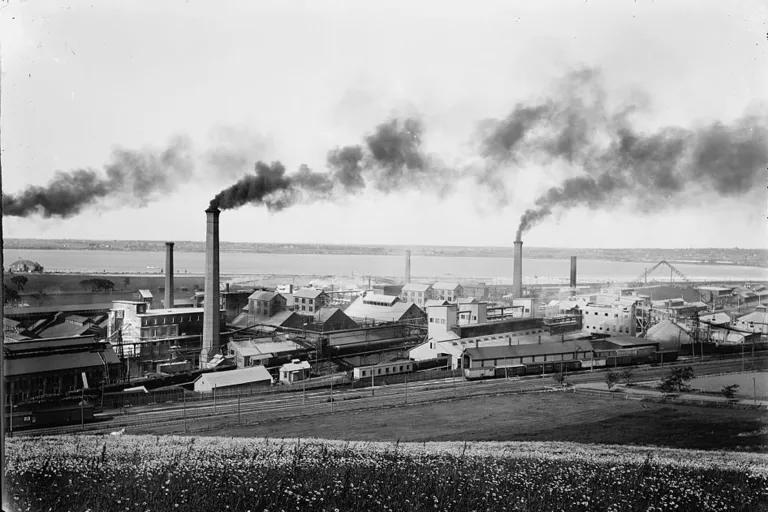
Chemical manufacturing plants emit fumes along Onondaga Lake in Solvay, New York, in the late-19th century. Over time, industrial development severely polluted the local area.
Library of Congress, Prints & Photographs Division, Detroit Publishing Company Collection
Scientists agree that human activity is the primary driver of what we’re seeing now worldwide. (This type of climate change is sometimes referred to as anthropogenic , which is just a way of saying “caused by human beings.”) The unchecked burning of fossil fuels over the past 150 years has drastically increased the presence of atmospheric greenhouse gases, most notably carbon dioxide . At the same time, logging and development have led to the widespread destruction of forests, wetlands, and other carbon sinks —natural resources that store carbon dioxide and prevent it from being released into the atmosphere.
Right now, atmospheric concentrations of greenhouse gases like carbon dioxide, methane , and nitrous oxide are the highest they’ve been in the last 800,000 years . Some greenhouse gases, like hydrochlorofluorocarbons (HFCs) , do not even exist in nature. By continuously pumping these gases into the air, we helped raise the earth’s average temperature by about 1.9 degrees Fahrenheit during the 20th century—which has brought us to our current era of deadly, and increasingly routine, weather extremes. And it’s important to note that while climate change affects everyone in some way, it doesn’t do so equally: All over the world, people of color and those living in economically disadvantaged or politically marginalized communities bear a much larger burden , despite the fact that these communities play a much smaller role in warming the planet.
Our ways of generating power for electricity, heat, and transportation, our built environment and industries, our ways of interacting with the land, and our consumption habits together serve as the primary drivers of climate change. While the percentages of greenhouse gases stemming from each source may fluctuate, the sources themselves remain relatively consistent.
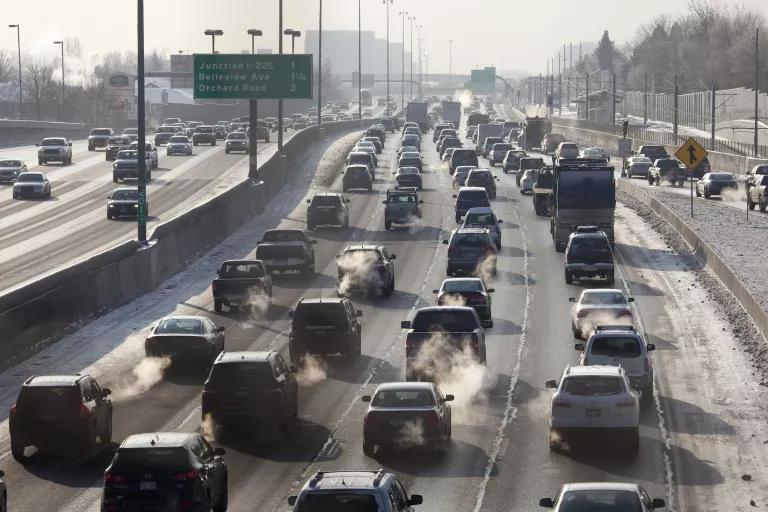
Traffic on Interstate 25 in Denver
David Parsons/iStock
The cars, trucks, ships, and planes that we use to transport ourselves and our goods are a major source of global greenhouse gas emissions. (In the United States, they actually constitute the single-largest source.) Burning petroleum-based fuel in combustion engines releases massive amounts of carbon dioxide into the atmosphere. Passenger cars account for 41 percent of those emissions, with the typical passenger vehicle emitting about 4.6 metric tons of carbon dioxide per year. And trucks are by far the worst polluters on the road. They run almost constantly and largely burn diesel fuel, which is why, despite accounting for just 4 percent of U.S. vehicles, trucks emit 23 percent of all greenhouse gas emissions from transportation.
We can get these numbers down, but we need large-scale investments to get more zero-emission vehicles on the road and increase access to reliable public transit .
As of 2021, nearly 60 percent of the electricity used in the United States comes from the burning of coal, natural gas , and other fossil fuels . Because of the electricity sector’s historical investment in these dirty energy sources, it accounts for roughly a quarter of U.S. greenhouse gas emissions, including carbon dioxide, methane, and nitrous oxide.
That history is undergoing a major change, however: As renewable energy sources like wind and solar become cheaper and easier to develop, utilities are turning to them more frequently. The percentage of clean, renewable energy is growing every year—and with that growth comes a corresponding decrease in pollutants.
But while things are moving in the right direction, they’re not moving fast enough. If we’re to keep the earth’s average temperature from rising more than 1.5 degrees Celsius, which scientists say we must do in order to avoid the very worst impacts of climate change, we have to take every available opportunity to speed up the shift from fossil fuels to renewables in the electricity sector.
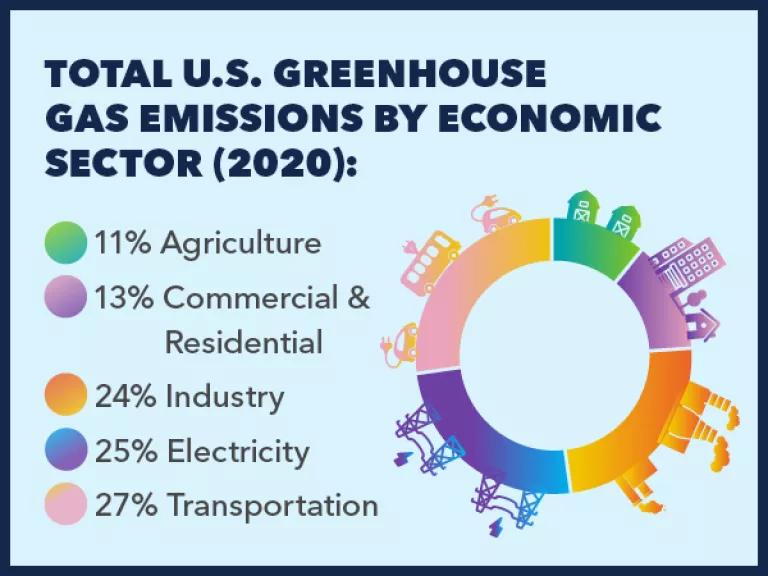
The factories and facilities that produce our goods are significant sources of greenhouse gases; in 2020, they were responsible for fully 24 percent of U.S. emissions. Most industrial emissions come from the production of a small set of carbon-intensive products, including basic chemicals, iron and steel, cement and concrete, aluminum, glass, and paper. To manufacture the building blocks of our infrastructure and the vast array of products demanded by consumers, producers must burn through massive amounts of energy. In addition, older facilities in need of efficiency upgrades frequently leak these gases, along with other harmful forms of air pollution .
One way to reduce the industrial sector’s carbon footprint is to increase efficiency through improved technology and stronger enforcement of pollution regulations. Another way is to rethink our attitudes toward consumption (particularly when it comes to plastics ), recycling , and reuse —so that we don’t need to be producing so many things in the first place. And, since major infrastructure projects rely heavily on industries like cement manufacturing (responsible for 7 percent of annual global greenhouse gas), policy mandates must leverage the government’s purchasing power to grow markets for cleaner alternatives, and ensure that state and federal agencies procure more sustainably produced materials for these projects. Hastening the switch from fossil fuels to renewables will also go a long way toward cleaning up this energy-intensive sector.
The advent of modern, industrialized agriculture has significantly altered the vital but delicate relationship between soil and the climate—so much so that agriculture accounted for 11 percent of U.S. greenhouse gas emissions in 2020. This sector is especially notorious for giving off large amounts of nitrous oxide and methane, powerful gases that are highly effective at trapping heat. The widespread adoption of chemical fertilizers , combined with certain crop-management practices that prioritize high yields over soil health, means that agriculture accounts for nearly three-quarters of the nitrous oxide found in our atmosphere. Meanwhile, large-scale industrialized livestock production continues to be a significant source of atmospheric methane, which is emitted as a function of the digestive processes of cattle and other ruminants.

Stephen McComber holds a squash harvested from the community garden in Kahnawà:ke Mohawk Territory, a First Nations reserve of the Mohawks of Kahnawà:ke, in Quebec.
Stephanie Foden for NRDC
But farmers and ranchers—especially Indigenous farmers, who have been tending the land according to sustainable principles —are reminding us that there’s more than one way to feed the world. By adopting the philosophies and methods associated with regenerative agriculture , we can slash emissions from this sector while boosting our soil’s capacity for sequestering carbon from the atmosphere, and producing healthier foods.
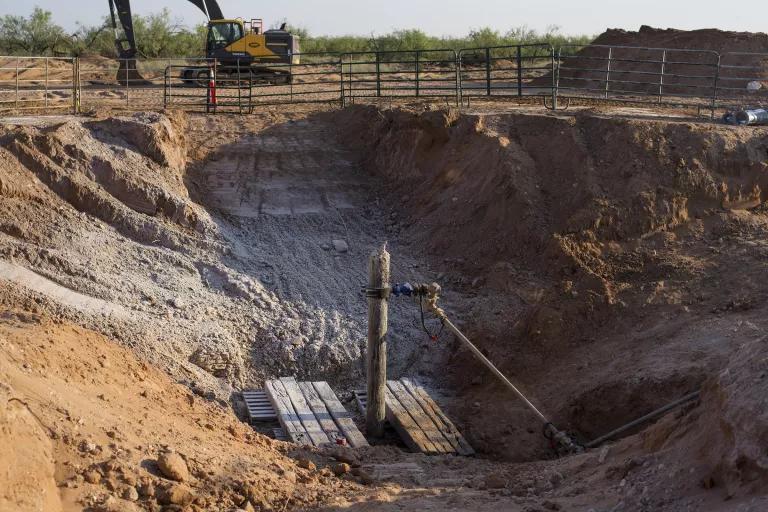
A decades-old, plugged and abandoned oil well at a cattle ranch in Crane County, Texas, in June 2021, when it was found to be leaking brine water
Matthew Busch/Bloomberg via Getty Images
Oil and gas lead to emissions at every stage of their production and consumption—not only when they’re burned as fuel, but just as soon as we drill a hole in the ground to begin extracting them. Fossil fuel development is a major source of methane, which invariably leaks from oil and gas operations : drilling, fracking , transporting, and refining. And while methane isn’t as prevalent a greenhouse gas as carbon dioxide, it’s many times more potent at trapping heat during the first 20 years of its release into the atmosphere. Even abandoned and inoperative wells—sometimes known as “orphaned” wells —leak methane. More than 3 million of these old, defunct wells are spread across the country and were responsible for emitting more than 280,000 metric tons of methane in 2018.
Unsurprisingly, given how much time we spend inside of them, our buildings—both residential and commercial—emit a lot of greenhouse gases. Heating, cooling, cooking, running appliances, and maintaining other building-wide systems accounted for 13 percent of U.S. emissions overall in 2020. And even worse, some 30 percent of the energy used in U.S. buildings goes to waste, on average.
Every day, great strides are being made in energy efficiency , allowing us to achieve the same (or even better) results with less energy expended. By requiring all new buildings to employ the highest efficiency standards—and by retrofitting existing buildings with the most up-to-date technologies—we’ll reduce emissions in this sector while simultaneously making it easier and cheaper for people in all communities to heat, cool, and power their homes: a top goal of the environmental justice movement.
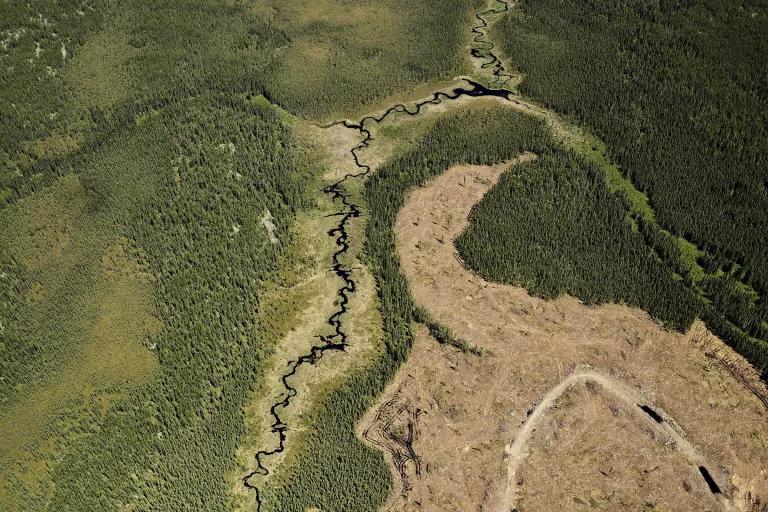
An aerial view of clearcut sections of boreal forest near Dryden in Northwestern Ontario, Canada, in June 2019
River Jordan for NRDC
Another way we’re injecting more greenhouse gas into the atmosphere is through the clearcutting of the world’s forests and the degradation of its wetlands . Vegetation and soil store carbon by keeping it at ground level or underground. Through logging and other forms of development, we’re cutting down or digging up vegetative biomass and releasing all of its stored carbon into the air. In Canada’s boreal forest alone, clearcutting is responsible for releasing more than 25 million metric tons of carbon dioxide into the atmosphere each year—the emissions equivalent of 5.5 million vehicles.
Government policies that emphasize sustainable practices, combined with shifts in consumer behavior , are needed to offset this dynamic and restore the planet’s carbon sinks .

The Yellow Line Metro train crossing over the Potomac River from Washington, DC, to Virginia on June 24, 2022
Sarah Baker
The decisions we make every day as individuals—which products we purchase, how much electricity we consume, how we get around, what we eat (and what we don’t—food waste makes up 4 percent of total U.S. greenhouse gas emissions)—add up to our single, unique carbon footprints . Put all of them together and you end up with humanity’s collective carbon footprint. The first step in reducing it is for us to acknowledge the uneven distribution of climate change’s causes and effects, and for those who bear the greatest responsibility for global greenhouse gas emissions to slash them without bringing further harm to those who are least responsible .
The big, climate-affecting decisions made by utilities, industries, and governments are shaped, in the end, by us : our needs, our demands, our priorities. Winning the fight against climate change will require us to rethink those needs, ramp up those demands , and reset those priorities. Short-term thinking of the sort that enriches corporations must give way to long-term planning that strengthens communities and secures the health and safety of all people. And our definition of climate advocacy must go beyond slogans and move, swiftly, into the realm of collective action—fueled by righteous anger, perhaps, but guided by faith in science and in our ability to change the world for the better.
If our activity has brought us to this dangerous point in human history, breaking old patterns can help us find a way out.
This NRDC.org story is available for online republication by news media outlets or nonprofits under these conditions: The writer(s) must be credited with a byline; you must note prominently that the story was originally published by NRDC.org and link to the original; the story cannot be edited (beyond simple things such as grammar); you can’t resell the story in any form or grant republishing rights to other outlets; you can’t republish our material wholesale or automatically—you need to select stories individually; you can’t republish the photos or graphics on our site without specific permission; you should drop us a note to let us know when you’ve used one of our stories.
We need climate action to be a top priority in Washington!
Tell President Biden and Congress to slash climate pollution and reduce our dependence on fossil fuels.

Urge President Biden and Congress to make equitable climate action a top priority in 2024
Related stories.
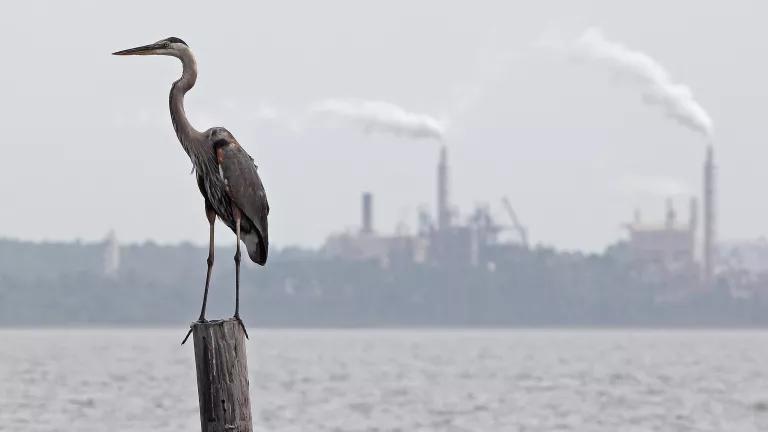
Greenhouse Effect 101

What Are the Solutions to Climate Change?
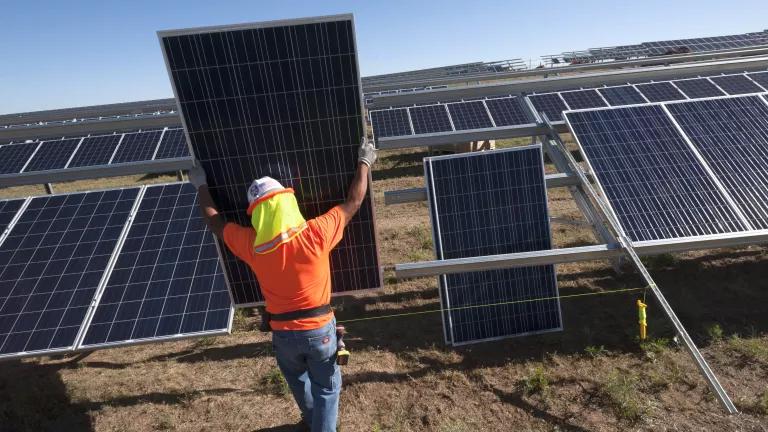
Failing to Meet Our Climate Goals Is Not an Option
When you sign up, you’ll become a member of NRDC’s Activist Network. We will keep you informed with the latest alerts and progress reports.
The Center for Global Studies
Climate change argumentation.
Carmen Vanderhoof, Curriculum and Instruction, College of Education, Penn State
Carmen Vanderhoof is a doctoral candidate in Science Education at Penn State. Her research employs multimodal discourse analysis of elementary students engaged in a collaborative engineering design challenge in order to examine students’ decision-making practices. Prior to resuming graduate studies, she was a secondary science teacher and conducted molecular biology research.
- Subject(s): Earth Science
- Topic: Climate Change and Sustainability
- Grade/Level: 9-12 (can be adapted to grades 6-8)
- Objectives: Students will be able to write a scientific argument using evidence and reasoning to support claims. Students will also be able to reflect on the weaknesses in their own arguments in order to improve their argument and then respond to other arguments.
- Suggested Time Allotment: 4-5 hours (extra time for extension)
This lesson is derived from Dr. Peter Buckland’s sustainability presentation for the Center for Global Studies . Dr. Peter Buckland, a Penn State alumnus, is a postdoctoral fellow for the Sustainability Institute. He has drawn together many resources for teaching about climate change, sustainability, and other environmental issues.
While there are many resources for teaching about climate change and sustainability, it may be tough to figure out where to start. There are massive amounts of data available to the general public and students need help searching for good sources of evidence. Prior to launching into a search, it would be worthwhile figuring out what the students already know about climate change, where they learned it, and how they feel about efforts to reduce our carbon footprint. There are many options for eliciting prior knowledge, including taking online quizzes, whole-class discussion, or drawing concept maps. For this initial step, it is important that students feel comfortable to share, without engaging in disagreements. The main idea is to increase students’ understanding about global warming, rather than focus on the potential controversial nature of this topic.
A major goal of this unit is to engage students in co-constructing evidence-based explanations through individual writing, sharing, re-writing, group discussion, and whole group reflection. The argumentation format presented here contains claims supported by evidence and reasoning (Claims Evidence Reasoning – CER). Argumentation in this sense is different from how the word “argument” is used in everyday language. Argumentation is a collaborative process towards an end goal, rather than a competition to win (Duschl & Osborne, 2002). Scientific argumentation is the process of negotiating and communicating findings through a series of claims supported by evidence from various sources along with a rationale or reasoning linking the claim with the evidence. For students, making the link between claim and evidence can be the most difficult part of the process.
Where does the evidence come from?
Evidence and data are often used synonymously, but there is a difference. Evidence is “the representation of data in a form that undergirds an argument that works to answer the original question” (Hand et al., 2009, p. 129). This explains why even though scientists may use the same data to draw explanations from, the final product may take different forms depending on which parts of the data were used and how. For example, in a court case experts from opposing sides may use the same data to persuade the jury to reach different conclusions. Another way to explain this distinction to students is “the story built from the data that leads to a claim is the evidence” (Hand et al., 2009, p. 129). Evidence can come from many sources – results from controlled experiments, measurements, books, articles, websites, personal observations, etc. It is important to discuss with students the issue of the source’s reliability and accuracy. When using data freely available online, ask yourself: Who conducted the study? Who funded the research? Where was it published or presented?
What is a claim and how do I find it?
A scientific claim is a statement that answers a question or an inference based on information, rather than just personal opinion.
How can I connect the claim(s) with the evidence?
That’s where the justification or reasoning comes in. This portion of the argument explains why the evidence is relevant to the claim or how the evidence supports the claim.
Implementation
Learning context and connecting to state standards.
This interdisciplinary unit can be used in an earth science class or adapted to environmental science, chemistry, or physics. The key to adapting the lesson is guiding students to sources of data that fit the discipline they are studying.
For earth science , students can explain the difference between climate and weather, describe the factors associated with global climate change, and explore a variety of data sources to draw their evidence from. Pennsylvania Academic Standards for earth and space science (secondary): 3.3.12.A1, 3.3.12.A6, 3.3.10.A7.
For environmental science , students can analyze the costs and benefits of pollution control measures. Pennsylvania Academic Standards for Environment and Ecology (secondary): 4.5.12.C.
For chemistry and physics , students can explain the function of greenhouse gases, construct a model of the greenhouse effect, and model energy flow through the atmosphere. Pennsylvania Academic Standards for Physical Sciences (secondary): 3.2.10.B6.
New Generation Science Standards (NGSS) Connections
Human impacts and global climate change are directly addressed in the NGSS. Disciplinary Core Ideas (DCI): HS-ESS3-3, HS-ESS3-4, HS-ESS3-5, HS-ESS3-6.
Lesson 1: Introduction to climate change
- What are greenhouse gases and the greenhouse effect? (sample answer: greenhouse gases like carbon dioxide and methane contribute to overall heating of the atmosphere; these gases trap heat just like the glass in a greenhouse or in a car)
- What is the difference between weather and climate? (sample answer: weather is the daily temperature and precipitation measurements, while climate is a much longer pattern over multiple years)
Drawing of the greenhouse effect – as individuals or in pairs, have students look up the greenhouse effect and draw a diagram to represent it; share out with the class
- Optional: figure out students’ beliefs about global warming using the Yale Six Americas Survey (students answer a series of questions and at the end they are given one of the following categories: alarmed, concerned, cautious, disengaged, doubtful, dismissive).
Lesson 2: Searching for and evaluating evidence
- Compare different data sources and assess their credibility
- Temperature
- Precipitation
- Storm surge
- Ask the students to think about what types of claims they can make about climate change using the data they found (Sample claims: human activity is causing global warming or sea-level rise in the next fifty years will affect coastal cities like Amsterdam, Hong Kong, or New Orleans).
Lesson 3: Writing an argument using evidence
- Claim – an inference or a statement that answers a question
- Evidence – an outside source of information that supports the claim, often drawn from selected data
- Reasoning – the justification/support for the claim; what connects the evidence with the claim
- Extending arguments – have students exchange papers and notice the strengths of the other arguments they are reading (can do multiple cycles of reading); ask students to go back to their original argument and expand it with more evidence and/or more justification for why the evidence supports the claim
- Anticipate Rebuttals – ask students to think and write about any weaknesses in their own argument
Lesson 4: Argumentation discussion
- rebuttal – challenges a component of someone’s argument – for example, a challenge to the evidence used in the original argument
- counterargument – a whole new argument that challenges the original argument
- respect group members and their ideas
- wait for group members to finish their turns before speaking
- be mindful of your own contributions to the discussion (try not to take over the whole discussion so others can contribute too; conversely, if you didn’t already talk, find a way to bring in a new argument, expand on an existing argument, or challenge another argument)
- Debate/discussion – In table groups have students share their arguments and practice rebuttals and counterarguments
- Whole-group reflection – ask students to share key points from their discussion
Lesson 5: Argumentation in action case study
Mumbai, india case study.
Rishi is a thirteen year old boy who attends the Gayak Rafi Nagar Urdu Municipal school in Mumbai. There is a massive landfill called Deonar right across from his school. Every day 4,000 tons of waste are piled on top of the existing garbage spanning 132 hectares (roughly half a square mile). Rishi ventures out to the landfill after school to look for materials that he can later trade for a little bit of extra money to help his family. He feels lucky that he gets to go to school during the day; others are not so lucky. One of his friends, Aamir, had to stop going to school and work full time after his dad got injured. They often meet to chat while they dig through the garbage with sticks. Occasionally, they find books in okay shape, which aren’t worth anything in trade, but to them they are valuable.
One day Rishi was out to the market with his mom and saw the sky darken with a heavy smoke that blocked out the sun. They both hurried home and found out there was a state of emergency and the schools closed for two days. It took many days to put out the fire at Deonar. He heard his dad say that the fire was so bad that it could be seen from space. He wonders what it would be like to see Mumbai from up there. Some days he wishes the government would close down Deonar and clean it up. Other days he wonders what would happen to all the people that depend on it to live if the city shuts down Deonar.
Mumbai is one of the coastal cities that are considered vulnerable with increasing global temperature and sea level rise. The urban poor are most affected by climate change. Their shelter could be wiped out by a tropical storm and rebuilding would be very difficult.

Write a letter to a public official who may be able to influence policy in Mumbai.
What would you recommend they do? Should they close Deonar? What can they do to reduce air pollution in the city and prepare for possible storms? Remember to use evidence in your argument.
If students want to read the articles that inspired the case study direct them to: http://unhabitat.org/urban-themes/climate-change/
http://www.bloomberg.com/slideshow/2012-07-06/top-20-cities-with-billions-at-risk-from-climate-change.html#slide16
http://www.bloomberg.com/news/articles/2015-07-26/smelly-dumps-drive-away-affordable-homes-in-land-starved-mumbai
http://www.cnn.com/2016/02/05/asia/mumbai-giant-garbage-dump-fire/
Resources:
- Lines of Evidence video from the National Academies of Sciences, Engineering, and Medicine http://nas-sites.org/americasclimatechoices/videos-multimedia/climate-change-lines-of-evidence-videos/
- Climate Literacy and Energy Awareness Network (CLEAN)
- Climate maps from the National Oceanic and Atmospheric Administration
- Sources of data from NASA
- Explore the original source of the Proceedings of the National Academies of Sciences (PNAS) study
Differentiated Instruction
- For visual learners – use diagrams, encourage students to map out their arguments prior to writing them
- For auditory learners – use the lines of evidence video
- For ESL students – provide them with a variety of greenhouse gases diagrams, allow for a more flexible argument format and focus on general meaning-making – ex. using arrows to connect their sources of evidence to claims
- For advanced learners – ask them to search through larger data sets and make comparisons between data from different sources; they can also research environmental policies and why they stalled out in congress
- For learners that need more support – print out excerpts from articles; pinpoint the main ideas to help with the research; help students connect their evidence with their claims; consider allowing students to work in pairs to accomplish the writing task
Argument write-up – check that students’ arguments contain claims supported by evidence and reasoning and that they thought about possible weaknesses in their own arguments.
Case study letter – check that students included evidence in their letter.
References:
Duschl, R. A., & Osborne, J. (2002). Supporting and promoting argumentation discourse in science education.
Hand, B. et al. (2009) Negotiating Science: The Critical Role of Argumentation in Student Inquiry. Portsmouth, NH: Heinemann.
McNeill, K. L., & Krajcik, J. (2012). Claim, evidence and reasoning: Supporting grade 5 – 8 students in constructing scientific explanations. New York, NY: Pearson Allyn & Bacon.
Sawyer, R. K. (Ed.). (2014). The Cambridge handbook of the learning sciences. New York, NY: Cambridge University Press.
https://www3.epa.gov/climatechange/kids/basics/today/greenhouse-gases.html
http://unhabitat.org/urban-themes/climate-change/

Why climate change is still the greatest threat to human health
Polluted air and steadily rising temperatures are linked to health effects ranging from increased heart attacks and strokes to the spread of infectious diseases and psychological trauma.
People around the world are witnessing firsthand how climate change can wreak havoc on the planet. Steadily rising average temperatures fuel increasingly intense wildfires, hurricanes, and other disasters that are now impossible to ignore. And while the world has been plunged into a deadly pandemic, scientists are sounding the alarm once more that climate change is still the greatest threat to human health in recorded history .
As recently as August—when wildfires raged in the United States, Europe, and Siberia—World Health Organization Director-General Tedros Adhanom Ghebreyesus said in a statement that “the risks posed by climate change could dwarf those of any single disease.”
On September 5, more than 200 medical journals released an unprecedented joint editorial that urged world leaders to act. “The science is unequivocal,” they write. “A global increase of 1.5°C above the pre-industrial average and the continued loss of biodiversity risk catastrophic harm to health that will be impossible to reverse.”
Despite the acute dangers posed by COVID-19, the authors of the joint op-ed write that world governments “cannot wait for the pandemic to pass to rapidly reduce emissions.” Instead, they argue, everyone must treat climate change with the same urgency as they have COVID-19.
Here’s a look at the ways that climate change can affect your health—including some less obvious but still insidious effects—and why scientists say it’s not too late to avert catastrophe.
Air pollution
Climate change is caused by an increase of carbon dioxide and other greenhouse gases in Earth’s atmosphere, mostly from fossil fuel emissions. But burning fossil fuels can also have direct consequences for human health. That’s because the polluted air contains small particles that can induce stroke and heart attacks by penetrating the lungs and heart and even traveling into the bloodstream. Those particles might harm the organs directly or provoke an inflammatory response from the immune system as it tries to fight them off. Estimates suggest that air pollution causes anywhere between 3.6 million and nine million premature deaths a year.
“The numbers do vary,” says Andy Haines , professor of environmental change and public health at the London School of Hygiene and Tropical Medicine and author of the recently published book Planetary Health . “But they all agree that it’s a big public health burden.”

People over the age of 65 are most susceptible to the harmful effects of air pollution, but many others are at risk too, says Kari Nadeau , director of the Sean N. Parker Center for Allergy and Asthma Research at Stanford University. People who smoke or vape are at increased risk, as are children with asthma.
FREE BONUS ISSUE
Air pollution also has consequences for those with allergies. Carbon dioxide increases the acidity of the air, which then pulls more pollen out from plants. For some people, this might just mean that they face annoyingly long bouts of seasonal allergies. But for others, it could be life-threatening.
“For people who already have respiratory disease, boy is that a problem,” Nadeau says. When pollen gets into the respiratory pathway, the body creates mucus to get rid of it, which can then fill up and suffocate the lungs.
Even healthy people can have similar outcomes if pollen levels are especially intense. In 2016, in the Australian state of Victoria, a severe thunderstorm combined with high levels of pollen to induce what The Lancet has described as “the world’s largest and most catastrophic epidemic of thunderstorm asthma.” So many residents suffered asthma attacks that emergency rooms were overwhelmed—and at least 10 people died as a result.
Climate change is also causing wildfires to get worse, and wildfire smoke is especially toxic. As one recent study showed, fires can account for 25 percent of dangerous air pollution in the U.S. Nadeau explains that the smoke contains particles of everything that the fire has consumed along its path—from rubber tires to harmful chemicals. These particles are tiny and can penetrate even deeper into a person’s lungs and organs. ( Here’s how breathing wildfire smoke affects the body .)
Extreme heat
Heat waves are deadly, but researchers at first didn’t see direct links between climate change and the harmful impacts of heat waves and other extreme weather events. Haines says the evidence base has been growing. “We have now got a number of studies which has shown that we can with high confidence attribute health outcomes to climate change,” he says.

Most recently, Haines points to a study published earlier this year in Nature Climate Change that attributes more than a third of heat-related deaths to climate change. As National Geographic reported at the time , the study found that the human toll was even higher in some countries with less access to air conditioning or other factors that render people more vulnerable to heat. ( How climate change is making heat waves even deadlier .)
That’s because the human body was not designed to cope with temperatures above 98.6°F, Nadeau says. Heat can break down muscles. The body does have some ways to deal with the heat—such as sweating. “But when it’s hot outside all the time, you cannot cope with that, and your heart muscles and cells start to literally die and degrade,” she says.
If you’re exposed to extreme heat for too long and are unable to adequately release that heat, the stress can cause a cascade of problems throughout the body. The heart has to work harder to pump blood to the rest of the organs, while sweat leeches the body of necessary minerals such as sodium and potassium. The combination can result in heart attacks and strokes .
Dehydration from heat exposure can also cause serious damage to the kidneys, which rely on water to function properly. For people whose kidneys are already beginning to fail—particularly older adults—Nadeau says that extreme heat can be a death sentence. “This is happening more and more,” she says.
Studies have also drawn links between higher temperatures and preterm birth and other pregnancy complications. It’s unclear why, but Haines says that one hypothesis is that extreme heat reduces blood flow to the fetus.
You May Also Like

Here’s what extreme heat does to the body

This summer's extreme weather is a sign of things to come

This African lake may literally explode—and millions are at risk
Food insecurity.
One of the less direct—but no less harmful—ways that climate change can affect health is by disrupting the world’s supply of food.
Climate change both reduces the amount of food that’s available and makes it less nutritious. According to an Intergovernmental Panel on Climate Change (IPCC) special report , crop yields have already begun to decline as a result of rising temperatures, changing precipitation patterns, and extreme weather events. Meanwhile, studies have shown that increased carbon dioxide in the atmosphere can leech plants of zinc, iron, and protein—nutrients that humans need to survive.

Malnutrition is linked to a variety of illnesses, including heart disease, cancer, and diabetes. It can also increase the risk of stunting, or impaired growth , in children, which can harm cognitive function.
Climate change also imperils what we eat from the sea. Rising ocean temperatures have led many fish species to migrate toward Earth’s poles in search of cooler waters. Haines says that the resulting decline of fish stocks in subtropic regions “has big implications for nutrition,” because many of those coastal communities depend on fish for a substantial amount of the protein in their diets.
This effect is likely to be particularly harmful for Indigenous communities, says Tiff-Annie Kenny, a professor in the faculty of medicine at Laval University in Quebec who studies climate change and food security in the Canadian Arctic. It’s much more difficult for these communities to find alternative sources of protein, she says, either because it’s not there or because it’s too expensive. “So what are people going to eat instead?” she asks.
Infectious diseases
As the planet gets hotter, the geographic region where ticks and mosquitoes like to live is getting wider. These animals are well-known vectors of diseases such as the Zika virus, dengue fever, and malaria. As they cross the tropics of Cancer and Capricorn, Nadeau says, mosquitoes and ticks bring more opportunities for these diseases to infect greater swaths of the world.
“It used to be that they stayed in those little sectors near the Equator, but now unfortunately because of the warming of northern Europe and Canada, you can find Zika in places you wouldn’t have expected,” Nadeau says.
In addition, climate conditions such as temperature and humidity can impact the life cycle of mosquitoes. Haines says there’s particularly good evidence showing that, in some regions, climate change has altered these conditions in ways that increase the risk of mosquitos transmitting dengue .
There are also several ways in which climate change is increasing the risk of diseases that can be transmitted through water, such as cholera, typhoid fever, and parasites. Sometimes that’s fairly direct, such as when people interact with dirty floodwaters. But Haines says that drought can have indirect impacts when people, say, can’t wash their hands or are forced to drink from dodgier sources of freshwater.
Mental health
A common result of any climate-linked disaster is the toll on mental health. The distress caused by drastic environmental change is so significant that it has been given its own name— solastalgia .

Nadeau says that the effects on mental health have been apparent in her studies of emergency room visits arising from wildfires in the western U.S. People lose their homes, their jobs, and sometimes their loved ones, and that takes an immediate toll. “What’s the fastest acute issue that develops? It’s psychological,” she says. Extreme weather events such as wildfires and hurricanes cause so much stress and anxiety that they can lead to post-traumatic stress disorder and even suicide in the long run.
Another common factor is that climate change causes disproportionate harm to the world’s most vulnerable people. On September 2, the Environmental Protection Agency (EPA) released an analysis showing that racial and ethnic minority communities are particularly at risk . According to the report, if temperatures rise by 2°C (3.6°F), Black people are 40 percent more likely to live in areas with the highest projected increases in related deaths. Another 34 percent are more likely to live in areas with a rise in childhood asthma.
Further, the effects of climate change don’t occur in isolation. At any given time, a community might face air pollution, food insecurity, disease, and extreme heat all at once. Kenny says that’s particularly devastating in communities where the prevalence of food insecurity and poverty are already high. This situation hasn’t been adequately studied, she says, because “it’s difficult to capture these shocks that climate can bring.”
Why there’s reason for hope
In recent years, scientists and environmental activists have begun to push for more research into the myriad health effects of climate change. “One of the striking things is there’s been a real dearth of funding for climate change and health,” Haines says. “For that reason, some of the evidence we have is still fragmentary.”
Still, hope is not lost. In the Paris Agreement, countries around the world have pledged to limit global warming to below 2°C (3.6°F)—and preferably to 1.5°C (2.7°F)—by cutting their emissions. “When you reduce those emissions, you benefit health as well as the planet,” Haines says.
Meanwhile, scientists and environmental activists have put forward solutions that can help people adapt to the health effects of climate change. These include early heat warnings and dedicated cooling centers, more resilient supply chains, and freeing healthcare facilities from dependence on the electric grid.
Nadeau argues that the COVID-19 pandemic also presents an opportunity for world leaders to think bigger and more strategically. For example, the pandemic has laid bare problems with efficiency and equity that have many countries restructuring their healthcare facilities. In the process, she says, they can look for new ways to reduce waste and emissions, such as getting more hospitals using renewable energy.
“This is in our hands to do,” Nadeau says. “If we don’t do anything, that would be cataclysmic.”
Related Topics
- AIR POLLUTION
- WATER QUALITY
- NATURAL DISASTERS AND HAZARDS
- PUBLIC HEALTH
- CLIMATE CHANGE

We got rid of BPA in some products—but are the substitutes any safer?

Long COVID can destroy your ability to exercise. Now we know why.

How the additives in your vaccines rev up your immune system
Fungi could be the key to major cancer research breakthroughs

What your biological age can reveal about your health
- History & Culture
- Photography
- Environment
- Paid Content
History & Culture
- History Magazine
- Mind, Body, Wonder
- Terms of Use
- Privacy Policy
- Your US State Privacy Rights
- Children's Online Privacy Policy
- Interest-Based Ads
- About Nielsen Measurement
- Do Not Sell or Share My Personal Information
- Nat Geo Home
- Attend a Live Event
- Book a Trip
- Inspire Your Kids
- Shop Nat Geo
- Visit the D.C. Museum
- Learn About Our Impact
- Support Our Mission
- Advertise With Us
- Customer Service
- Renew Subscription
- Manage Your Subscription
- Work at Nat Geo
- Sign Up for Our Newsletters
- Contribute to Protect the Planet
Copyright © 1996-2015 National Geographic Society Copyright © 2015-2024 National Geographic Partners, LLC. All rights reserved
What evidence exists that Earth is warming and that humans are the main cause?
We know the world is warming because people have been recording daily high and low temperatures at thousands of weather stations worldwide, over land and ocean, for many decades and, in some locations, for more than a century. When different teams of climate scientists in different agencies (e.g., NOAA and NASA) and in other countries (e.g., the U.K.’s Hadley Centre) average these data together, they all find essentially the same result: Earth’s average surface temperature has risen by about 1.8°F (1.0°C) since 1880.
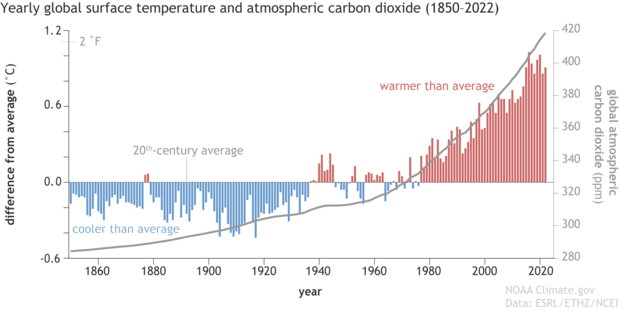
Yearly temperature compared to the twentieth-century average (red bars mean warmer than average, blue bars mean colder than average) from 1850–2022 and atmospheric carbon dioxide amounts (gray line): 1850-1958 from IAC , 1959-2019 from NOAA ESRL . Original graph by Dr. Howard Diamond (NOAA ARL), and adapted by NOAA Climate.gov.
In addition to our surface station data, we have many different lines of evidence that Earth is warming ( learn more ). Birds are migrating earlier, and their migration patterns are changing. Lobsters and other marine species are moving north. Plants are blooming earlier in the spring. Mountain glaciers are melting worldwide, and snow cover is declining in the Northern Hemisphere (Learn more here and here ). Greenland’s ice sheet—which holds about 8 percent of Earth’s fresh water—is melting at an accelerating rate ( learn more ). Mean global sea level is rising ( learn more ). Arctic sea ice is declining rapidly in both thickness and extent ( learn more ).
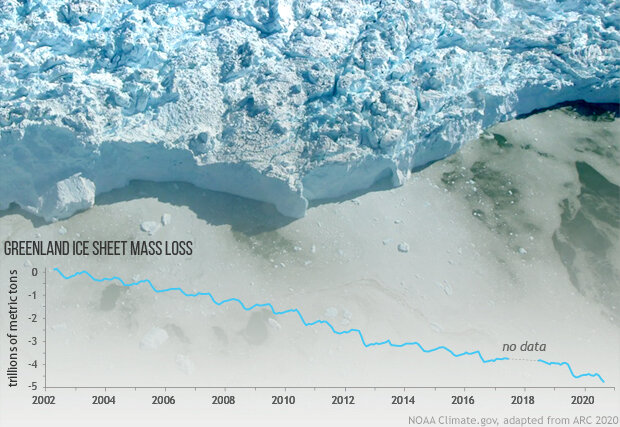
The Greenland Ice Sheet lost mass again in 2020, but not as much as it did 2019. Adapted from the 2020 Arctic Report Card, this graph tracks Greenland mass loss measured by NASA's GRACE satellite missions since 2002. The background photo shows a glacier calving front in western Greenland, captured from an airplane during a NASA Operation IceBridge field campaign. Full story.
We know this warming is largely caused by human activities because the key role that carbon dioxide plays in maintaining Earth’s natural greenhouse effect has been understood since the mid-1800s. Unless it is offset by some equally large cooling influence, more atmospheric carbon dioxide will lead to warmer surface temperatures. Since 1800, the amount of carbon dioxide in the atmosphere has increased from about 280 parts per million to 410 ppm in 2019. We know from both its rapid increase and its isotopic “fingerprint” that the source of this new carbon dioxide is fossil fuels, and not natural sources like forest fires, volcanoes, or outgassing from the ocean.
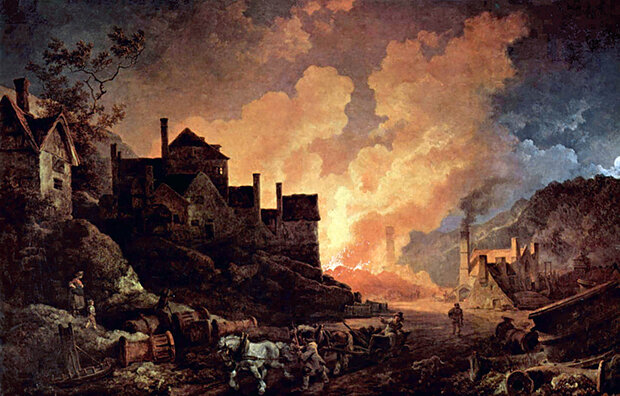
Philip James de Loutherbourg's 1801 painting, Coalbrookdale by Night , came to symbolize the start of the Industrial Revolution, when humans began to harness the power of fossil fuels—and to contribute significantly to Earth's atmospheric greenhouse gas composition. Image from Wikipedia .
Finally, no other known climate influences have changed enough to account for the observed warming trend. Taken together, these and other lines of evidence point squarely to human activities as the cause of recent global warming.
USGCRP (2017). Climate Science Special Report: Fourth National Climate Assessment, Volume 1 [Wuebbles, D.J., D.W. Fahey, K.A. Hibbard, D.J. Dokken, B.C. Stewart, and T.K. Maycock (eds.)]. U.S. Global Change Research Program, Washington, DC, USA, 470 pp, doi: 10.7930/J0J964J6 .
National Fish, Wildlife, and Plants Climate Adaptation Partnership (2012): National Fish, Wildlife, and Plants Climate Adaptation Strategy . Association of Fish and Wildlife Agencies, Council on Environmental Quality, Great Lakes Indian Fish and Wildlife Commission, National Oceanic and Atmospheric Administration, and U.S. Fish and Wildlife Service. Washington, D.C. DOI: 10.3996/082012-FWSReport-1
IPCC (2019). Summary for Policymakers. In: IPCC Special Report on the Ocean and Cryosphere in a Changing Climate. [H.-O. Pörtner, D.C. Roberts, V. Masson-Delmotte, P. Zhai, M. Tignor, E. Poloczanska, K. Mintenbeck, A. Alegría, M. Nicolai, A. Okem, J. Petzold, B. Rama, N.M. Weyer (eds.)]. In press.
NASA JPL: "Consensus: 97% of climate scientists agree." Global Climate Change . A website at NASA's Jet Propulsion Laboratory (climate.nasa.gov/scientific-consensus). (Accessed July 2013.)
We value your feedback
Help us improve our content
Related Content
News & features, 2017 state of the climate: mountain glaciers, warming waters shift fish communities northward in the arctic, climate & fish sticks, maps & data, past climate, land - terrestrial climate variables, future climate, teaching climate, toolbox for teaching climate & energy, student climate & conservation congress (sc3), climate youth engagement, climate resilience toolkit, arctic oceans, sea ice, and coasts, alaska and the arctic, agriculture and ecosystems.
- Share full article

The Science of Climate Change Explained: Facts, Evidence and Proof
Definitive answers to the big questions.
Credit... Photo Illustration by Andrea D'Aquino
Supported by
By Julia Rosen
Ms. Rosen is a journalist with a Ph.D. in geology. Her research involved studying ice cores from Greenland and Antarctica to understand past climate changes.
- Published April 19, 2021 Updated Nov. 6, 2021
The science of climate change is more solid and widely agreed upon than you might think. But the scope of the topic, as well as rampant disinformation, can make it hard to separate fact from fiction. Here, we’ve done our best to present you with not only the most accurate scientific information, but also an explanation of how we know it.
How do we know climate change is really happening?
How much agreement is there among scientists about climate change, do we really only have 150 years of climate data how is that enough to tell us about centuries of change, how do we know climate change is caused by humans, since greenhouse gases occur naturally, how do we know they’re causing earth’s temperature to rise, why should we be worried that the planet has warmed 2°f since the 1800s, is climate change a part of the planet’s natural warming and cooling cycles, how do we know global warming is not because of the sun or volcanoes, how can winters and certain places be getting colder if the planet is warming, wildfires and bad weather have always happened. how do we know there’s a connection to climate change, how bad are the effects of climate change going to be, what will it cost to do something about climate change, versus doing nothing.
Climate change is often cast as a prediction made by complicated computer models. But the scientific basis for climate change is much broader, and models are actually only one part of it (and, for what it’s worth, they’re surprisingly accurate ).
For more than a century , scientists have understood the basic physics behind why greenhouse gases like carbon dioxide cause warming. These gases make up just a small fraction of the atmosphere but exert outsized control on Earth’s climate by trapping some of the planet’s heat before it escapes into space. This greenhouse effect is important: It’s why a planet so far from the sun has liquid water and life!
However, during the Industrial Revolution, people started burning coal and other fossil fuels to power factories, smelters and steam engines, which added more greenhouse gases to the atmosphere. Ever since, human activities have been heating the planet.
We know this is true thanks to an overwhelming body of evidence that begins with temperature measurements taken at weather stations and on ships starting in the mid-1800s. Later, scientists began tracking surface temperatures with satellites and looking for clues about climate change in geologic records. Together, these data all tell the same story: Earth is getting hotter.
Average global temperatures have increased by 2.2 degrees Fahrenheit, or 1.2 degrees Celsius, since 1880, with the greatest changes happening in the late 20th century. Land areas have warmed more than the sea surface and the Arctic has warmed the most — by more than 4 degrees Fahrenheit just since the 1960s. Temperature extremes have also shifted. In the United States, daily record highs now outnumber record lows two-to-one.

Where it was cooler or warmer in 2020 compared with the middle of the 20th century

This warming is unprecedented in recent geologic history. A famous illustration, first published in 1998 and often called the hockey-stick graph, shows how temperatures remained fairly flat for centuries (the shaft of the stick) before turning sharply upward (the blade). It’s based on data from tree rings, ice cores and other natural indicators. And the basic picture , which has withstood decades of scrutiny from climate scientists and contrarians alike, shows that Earth is hotter today than it’s been in at least 1,000 years, and probably much longer.
In fact, surface temperatures actually mask the true scale of climate change, because the ocean has absorbed 90 percent of the heat trapped by greenhouse gases . Measurements collected over the last six decades by oceanographic expeditions and networks of floating instruments show that every layer of the ocean is warming up. According to one study , the ocean has absorbed as much heat between 1997 and 2015 as it did in the previous 130 years.
We also know that climate change is happening because we see the effects everywhere. Ice sheets and glaciers are shrinking while sea levels are rising. Arctic sea ice is disappearing. In the spring, snow melts sooner and plants flower earlier. Animals are moving to higher elevations and latitudes to find cooler conditions. And droughts, floods and wildfires have all gotten more extreme. Models predicted many of these changes, but observations show they are now coming to pass.
Back to top .
There’s no denying that scientists love a good, old-fashioned argument. But when it comes to climate change, there is virtually no debate: Numerous studies have found that more than 90 percent of scientists who study Earth’s climate agree that the planet is warming and that humans are the primary cause. Most major scientific bodies, from NASA to the World Meteorological Organization , endorse this view. That’s an astounding level of consensus given the contrarian, competitive nature of the scientific enterprise, where questions like what killed the dinosaurs remain bitterly contested .
Scientific agreement about climate change started to emerge in the late 1980s, when the influence of human-caused warming began to rise above natural climate variability. By 1991, two-thirds of earth and atmospheric scientists surveyed for an early consensus study said that they accepted the idea of anthropogenic global warming. And by 1995, the Intergovernmental Panel on Climate Change, a famously conservative body that periodically takes stock of the state of scientific knowledge, concluded that “the balance of evidence suggests that there is a discernible human influence on global climate.” Currently, more than 97 percent of publishing climate scientists agree on the existence and cause of climate change (as does nearly 60 percent of the general population of the United States).
So where did we get the idea that there’s still debate about climate change? A lot of it came from coordinated messaging campaigns by companies and politicians that opposed climate action. Many pushed the narrative that scientists still hadn’t made up their minds about climate change, even though that was misleading. Frank Luntz, a Republican consultant, explained the rationale in an infamous 2002 memo to conservative lawmakers: “Should the public come to believe that the scientific issues are settled, their views about global warming will change accordingly,” he wrote. Questioning consensus remains a common talking point today, and the 97 percent figure has become something of a lightning rod .
To bolster the falsehood of lingering scientific doubt, some people have pointed to things like the Global Warming Petition Project, which urged the United States government to reject the Kyoto Protocol of 1997, an early international climate agreement. The petition proclaimed that climate change wasn’t happening, and even if it were, it wouldn’t be bad for humanity. Since 1998, more than 30,000 people with science degrees have signed it. However, nearly 90 percent of them studied something other than Earth, atmospheric or environmental science, and the signatories included just 39 climatologists. Most were engineers, doctors, and others whose training had little to do with the physics of the climate system.
A few well-known researchers remain opposed to the scientific consensus. Some, like Willie Soon, a researcher affiliated with the Harvard-Smithsonian Center for Astrophysics, have ties to the fossil fuel industry . Others do not, but their assertions have not held up under the weight of evidence. At least one prominent skeptic, the physicist Richard Muller, changed his mind after reassessing historical temperature data as part of the Berkeley Earth project. His team’s findings essentially confirmed the results he had set out to investigate, and he came away firmly convinced that human activities were warming the planet. “Call me a converted skeptic,” he wrote in an Op-Ed for the Times in 2012.
Mr. Luntz, the Republican pollster, has also reversed his position on climate change and now advises politicians on how to motivate climate action.
A final note on uncertainty: Denialists often use it as evidence that climate science isn’t settled. However, in science, uncertainty doesn’t imply a lack of knowledge. Rather, it’s a measure of how well something is known. In the case of climate change, scientists have found a range of possible future changes in temperature, precipitation and other important variables — which will depend largely on how quickly we reduce emissions. But uncertainty does not undermine their confidence that climate change is real and that people are causing it.
Earth’s climate is inherently variable. Some years are hot and others are cold, some decades bring more hurricanes than others, some ancient droughts spanned the better part of centuries. Glacial cycles operate over many millenniums. So how can scientists look at data collected over a relatively short period of time and conclude that humans are warming the planet? The answer is that the instrumental temperature data that we have tells us a lot, but it’s not all we have to go on.
Historical records stretch back to the 1880s (and often before), when people began to regularly measure temperatures at weather stations and on ships as they traversed the world’s oceans. These data show a clear warming trend during the 20th century.

Global average temperature compared with the middle of the 20th century
+0.75°C
–0.25°

Some have questioned whether these records could be skewed, for instance, by the fact that a disproportionate number of weather stations are near cities, which tend to be hotter than surrounding areas as a result of the so-called urban heat island effect. However, researchers regularly correct for these potential biases when reconstructing global temperatures. In addition, warming is corroborated by independent data like satellite observations, which cover the whole planet, and other ways of measuring temperature changes.
Much has also been made of the small dips and pauses that punctuate the rising temperature trend of the last 150 years. But these are just the result of natural climate variability or other human activities that temporarily counteract greenhouse warming. For instance, in the mid-1900s, internal climate dynamics and light-blocking pollution from coal-fired power plants halted global warming for a few decades. (Eventually, rising greenhouse gases and pollution-control laws caused the planet to start heating up again.) Likewise, the so-called warming hiatus of the 2000s was partly a result of natural climate variability that allowed more heat to enter the ocean rather than warm the atmosphere. The years since have been the hottest on record .
Still, could the entire 20th century just be one big natural climate wiggle? To address that question, we can look at other kinds of data that give a longer perspective. Researchers have used geologic records like tree rings, ice cores, corals and sediments that preserve information about prehistoric climates to extend the climate record. The resulting picture of global temperature change is basically flat for centuries, then turns sharply upward over the last 150 years. It has been a target of climate denialists for decades. However, study after study has confirmed the results , which show that the planet hasn’t been this hot in at least 1,000 years, and probably longer.
Scientists have studied past climate changes to understand the factors that can cause the planet to warm or cool. The big ones are changes in solar energy, ocean circulation, volcanic activity and the amount of greenhouse gases in the atmosphere. And they have each played a role at times.
For example, 300 years ago, a combination of reduced solar output and increased volcanic activity cooled parts of the planet enough that Londoners regularly ice skated on the Thames . About 12,000 years ago, major changes in Atlantic circulation plunged the Northern Hemisphere into a frigid state. And 56 million years ago, a giant burst of greenhouse gases, from volcanic activity or vast deposits of methane (or both), abruptly warmed the planet by at least 9 degrees Fahrenheit, scrambling the climate, choking the oceans and triggering mass extinctions.
In trying to determine the cause of current climate changes, scientists have looked at all of these factors . The first three have varied a bit over the last few centuries and they have quite likely had modest effects on climate , particularly before 1950. But they cannot account for the planet’s rapidly rising temperature, especially in the second half of the 20th century, when solar output actually declined and volcanic eruptions exerted a cooling effect.
That warming is best explained by rising greenhouse gas concentrations . Greenhouse gases have a powerful effect on climate (see the next question for why). And since the Industrial Revolution, humans have been adding more of them to the atmosphere, primarily by extracting and burning fossil fuels like coal, oil and gas, which releases carbon dioxide.
Bubbles of ancient air trapped in ice show that, before about 1750, the concentration of carbon dioxide in the atmosphere was roughly 280 parts per million. It began to rise slowly and crossed the 300 p.p.m. threshold around 1900. CO2 levels then accelerated as cars and electricity became big parts of modern life, recently topping 420 p.p.m . The concentration of methane, the second most important greenhouse gas, has more than doubled. We’re now emitting carbon much faster than it was released 56 million years ago .

30 billion metric tons
Carbon dioxide emitted worldwide 1850-2017
Rest of world
Other developed
European Union
Developed economies
Other countries
United States

E.U. and U.K.

These rapid increases in greenhouse gases have caused the climate to warm abruptly. In fact, climate models suggest that greenhouse warming can explain virtually all of the temperature change since 1950. According to the most recent report by the Intergovernmental Panel on Climate Change, which assesses published scientific literature, natural drivers and internal climate variability can only explain a small fraction of late-20th century warming.
Another study put it this way: The odds of current warming occurring without anthropogenic greenhouse gas emissions are less than 1 in 100,000 .
But greenhouse gases aren’t the only climate-altering compounds people put into the air. Burning fossil fuels also produces particulate pollution that reflects sunlight and cools the planet. Scientists estimate that this pollution has masked up to half of the greenhouse warming we would have otherwise experienced.
Greenhouse gases like water vapor and carbon dioxide serve an important role in the climate. Without them, Earth would be far too cold to maintain liquid water and humans would not exist!
Here’s how it works: the planet’s temperature is basically a function of the energy the Earth absorbs from the sun (which heats it up) and the energy Earth emits to space as infrared radiation (which cools it down). Because of their molecular structure, greenhouse gases temporarily absorb some of that outgoing infrared radiation and then re-emit it in all directions, sending some of that energy back toward the surface and heating the planet . Scientists have understood this process since the 1850s .
Greenhouse gas concentrations have varied naturally in the past. Over millions of years, atmospheric CO2 levels have changed depending on how much of the gas volcanoes belched into the air and how much got removed through geologic processes. On time scales of hundreds to thousands of years, concentrations have changed as carbon has cycled between the ocean, soil and air.
Today, however, we are the ones causing CO2 levels to increase at an unprecedented pace by taking ancient carbon from geologic deposits of fossil fuels and putting it into the atmosphere when we burn them. Since 1750, carbon dioxide concentrations have increased by almost 50 percent. Methane and nitrous oxide, other important anthropogenic greenhouse gases that are released mainly by agricultural activities, have also spiked over the last 250 years.
We know based on the physics described above that this should cause the climate to warm. We also see certain telltale “fingerprints” of greenhouse warming. For example, nights are warming even faster than days because greenhouse gases don’t go away when the sun sets. And upper layers of the atmosphere have actually cooled, because more energy is being trapped by greenhouse gases in the lower atmosphere.
We also know that we are the cause of rising greenhouse gas concentrations — and not just because we can measure the CO2 coming out of tailpipes and smokestacks. We can see it in the chemical signature of the carbon in CO2.
Carbon comes in three different masses: 12, 13 and 14. Things made of organic matter (including fossil fuels) tend to have relatively less carbon-13. Volcanoes tend to produce CO2 with relatively more carbon-13. And over the last century, the carbon in atmospheric CO2 has gotten lighter, pointing to an organic source.
We can tell it’s old organic matter by looking for carbon-14, which is radioactive and decays over time. Fossil fuels are too ancient to have any carbon-14 left in them, so if they were behind rising CO2 levels, you would expect the amount of carbon-14 in the atmosphere to drop, which is exactly what the data show .
It’s important to note that water vapor is the most abundant greenhouse gas in the atmosphere. However, it does not cause warming; instead it responds to it . That’s because warmer air holds more moisture, which creates a snowball effect in which human-caused warming allows the atmosphere to hold more water vapor and further amplifies climate change. This so-called feedback cycle has doubled the warming caused by anthropogenic greenhouse gas emissions.
A common source of confusion when it comes to climate change is the difference between weather and climate. Weather is the constantly changing set of meteorological conditions that we experience when we step outside, whereas climate is the long-term average of those conditions, usually calculated over a 30-year period. Or, as some say: Weather is your mood and climate is your personality.
So while 2 degrees Fahrenheit doesn’t represent a big change in the weather, it’s a huge change in climate. As we’ve already seen, it’s enough to melt ice and raise sea levels, to shift rainfall patterns around the world and to reorganize ecosystems, sending animals scurrying toward cooler habitats and killing trees by the millions.
It’s also important to remember that two degrees represents the global average, and many parts of the world have already warmed by more than that. For example, land areas have warmed about twice as much as the sea surface. And the Arctic has warmed by about 5 degrees. That’s because the loss of snow and ice at high latitudes allows the ground to absorb more energy, causing additional heating on top of greenhouse warming.
Relatively small long-term changes in climate averages also shift extremes in significant ways. For instance, heat waves have always happened, but they have shattered records in recent years. In June of 2020, a town in Siberia registered temperatures of 100 degrees . And in Australia, meteorologists have added a new color to their weather maps to show areas where temperatures exceed 125 degrees. Rising sea levels have also increased the risk of flooding because of storm surges and high tides. These are the foreshocks of climate change.
And we are in for more changes in the future — up to 9 degrees Fahrenheit of average global warming by the end of the century, in the worst-case scenario . For reference, the difference in global average temperatures between now and the peak of the last ice age, when ice sheets covered large parts of North America and Europe, is about 11 degrees Fahrenheit.
Under the Paris Climate Agreement, which President Biden recently rejoined, countries have agreed to try to limit total warming to between 1.5 and 2 degrees Celsius, or 2.7 and 3.6 degrees Fahrenheit, since preindustrial times. And even this narrow range has huge implications . According to scientific studies, the difference between 2.7 and 3.6 degrees Fahrenheit will very likely mean the difference between coral reefs hanging on or going extinct, and between summer sea ice persisting in the Arctic or disappearing completely. It will also determine how many millions of people suffer from water scarcity and crop failures, and how many are driven from their homes by rising seas. In other words, one degree Fahrenheit makes a world of difference.
Earth’s climate has always changed. Hundreds of millions of years ago, the entire planet froze . Fifty million years ago, alligators lived in what we now call the Arctic . And for the last 2.6 million years, the planet has cycled between ice ages when the planet was up to 11 degrees cooler and ice sheets covered much of North America and Europe, and milder interglacial periods like the one we’re in now.
Climate denialists often point to these natural climate changes as a way to cast doubt on the idea that humans are causing climate to change today. However, that argument rests on a logical fallacy. It’s like “seeing a murdered body and concluding that people have died of natural causes in the past, so the murder victim must also have died of natural causes,” a team of social scientists wrote in The Debunking Handbook , which explains the misinformation strategies behind many climate myths.
Indeed, we know that different mechanisms caused the climate to change in the past. Glacial cycles, for example, were triggered by periodic variations in Earth’s orbit , which take place over tens of thousands of years and change how solar energy gets distributed around the globe and across the seasons.
These orbital variations don’t affect the planet’s temperature much on their own. But they set off a cascade of other changes in the climate system; for instance, growing or melting vast Northern Hemisphere ice sheets and altering ocean circulation. These changes, in turn, affect climate by altering the amount of snow and ice, which reflect sunlight, and by changing greenhouse gas concentrations. This is actually part of how we know that greenhouse gases have the ability to significantly affect Earth’s temperature.
For at least the last 800,000 years , atmospheric CO2 concentrations oscillated between about 180 parts per million during ice ages and about 280 p.p.m. during warmer periods, as carbon moved between oceans, forests, soils and the atmosphere. These changes occurred in lock step with global temperatures, and are a major reason the entire planet warmed and cooled during glacial cycles, not just the frozen poles.
Today, however, CO2 levels have soared to 420 p.p.m. — the highest they’ve been in at least three million years . The concentration of CO2 is also increasing about 100 times faster than it did at the end of the last ice age. This suggests something else is going on, and we know what it is: Since the Industrial Revolution, humans have been burning fossil fuels and releasing greenhouse gases that are heating the planet now (see Question 5 for more details on how we know this, and Questions 4 and 8 for how we know that other natural forces aren’t to blame).
Over the next century or two, societies and ecosystems will experience the consequences of this climate change. But our emissions will have even more lasting geologic impacts: According to some studies, greenhouse gas levels may have already warmed the planet enough to delay the onset of the next glacial cycle for at least an additional 50,000 years.
The sun is the ultimate source of energy in Earth’s climate system, so it’s a natural candidate for causing climate change. And solar activity has certainly changed over time. We know from satellite measurements and other astronomical observations that the sun’s output changes on 11-year cycles. Geologic records and sunspot numbers, which astronomers have tracked for centuries, also show long-term variations in the sun’s activity, including some exceptionally quiet periods in the late 1600s and early 1800s.
We know that, from 1900 until the 1950s, solar irradiance increased. And studies suggest that this had a modest effect on early 20th century climate, explaining up to 10 percent of the warming that’s occurred since the late 1800s. However, in the second half of the century, when the most warming occurred, solar activity actually declined . This disparity is one of the main reasons we know that the sun is not the driving force behind climate change.
Another reason we know that solar activity hasn’t caused recent warming is that, if it had, all the layers of the atmosphere should be heating up. Instead, data show that the upper atmosphere has actually cooled in recent decades — a hallmark of greenhouse warming .
So how about volcanoes? Eruptions cool the planet by injecting ash and aerosol particles into the atmosphere that reflect sunlight. We’ve observed this effect in the years following large eruptions. There are also some notable historical examples, like when Iceland’s Laki volcano erupted in 1783, causing widespread crop failures in Europe and beyond, and the “ year without a summer ,” which followed the 1815 eruption of Mount Tambora in Indonesia.
Since volcanoes mainly act as climate coolers, they can’t really explain recent warming. However, scientists say that they may also have contributed slightly to rising temperatures in the early 20th century. That’s because there were several large eruptions in the late 1800s that cooled the planet, followed by a few decades with no major volcanic events when warming caught up. During the second half of the 20th century, though, several big eruptions occurred as the planet was heating up fast. If anything, they temporarily masked some amount of human-caused warming.
The second way volcanoes can impact climate is by emitting carbon dioxide. This is important on time scales of millions of years — it’s what keeps the planet habitable (see Question 5 for more on the greenhouse effect). But by comparison to modern anthropogenic emissions, even big eruptions like Krakatoa and Mount St. Helens are just a drop in the bucket. After all, they last only a few hours or days, while we burn fossil fuels 24-7. Studies suggest that, today, volcanoes account for 1 to 2 percent of total CO2 emissions.
When a big snowstorm hits the United States, climate denialists can try to cite it as proof that climate change isn’t happening. In 2015, Senator James Inhofe, an Oklahoma Republican, famously lobbed a snowball in the Senate as he denounced climate science. But these events don’t actually disprove climate change.
While there have been some memorable storms in recent years, winters are actually warming across the world. In the United States, average temperatures in December, January and February have increased by about 2.5 degrees this century.
On the flip side, record cold days are becoming less common than record warm days. In the United States, record highs now outnumber record lows two-to-one . And ever-smaller areas of the country experience extremely cold winter temperatures . (The same trends are happening globally.)
So what’s with the blizzards? Weather always varies, so it’s no surprise that we still have severe winter storms even as average temperatures rise. However, some studies suggest that climate change may be to blame. One possibility is that rapid Arctic warming has affected atmospheric circulation, including the fast-flowing, high-altitude air that usually swirls over the North Pole (a.k.a. the Polar Vortex ). Some studies suggest that these changes are bringing more frigid temperatures to lower latitudes and causing weather systems to stall , allowing storms to produce more snowfall. This may explain what we’ve experienced in the U.S. over the past few decades, as well as a wintertime cooling trend in Siberia , although exactly how the Arctic affects global weather remains a topic of ongoing scientific debate .
Climate change may also explain the apparent paradox behind some of the other places on Earth that haven’t warmed much. For instance, a splotch of water in the North Atlantic has cooled in recent years, and scientists say they suspect that may be because ocean circulation is slowing as a result of freshwater streaming off a melting Greenland . If this circulation grinds almost to a halt, as it’s done in the geologic past, it would alter weather patterns around the world.
Not all cold weather stems from some counterintuitive consequence of climate change. But it’s a good reminder that Earth’s climate system is complex and chaotic, so the effects of human-caused changes will play out differently in different places. That’s why “global warming” is a bit of an oversimplification. Instead, some scientists have suggested that the phenomenon of human-caused climate change would more aptly be called “ global weirding .”
Extreme weather and natural disasters are part of life on Earth — just ask the dinosaurs. But there is good evidence that climate change has increased the frequency and severity of certain phenomena like heat waves, droughts and floods. Recent research has also allowed scientists to identify the influence of climate change on specific events.
Let’s start with heat waves . Studies show that stretches of abnormally high temperatures now happen about five times more often than they would without climate change, and they last longer, too. Climate models project that, by the 2040s, heat waves will be about 12 times more frequent. And that’s concerning since extreme heat often causes increased hospitalizations and deaths, particularly among older people and those with underlying health conditions. In the summer of 2003, for example, a heat wave caused an estimated 70,000 excess deaths across Europe. (Human-caused warming amplified the death toll .)
Climate change has also exacerbated droughts , primarily by increasing evaporation. Droughts occur naturally because of random climate variability and factors like whether El Niño or La Niña conditions prevail in the tropical Pacific. But some researchers have found evidence that greenhouse warming has been affecting droughts since even before the Dust Bowl . And it continues to do so today. According to one analysis , the drought that afflicted the American Southwest from 2000 to 2018 was almost 50 percent more severe because of climate change. It was the worst drought the region had experienced in more than 1,000 years.
Rising temperatures have also increased the intensity of heavy precipitation events and the flooding that often follows. For example, studies have found that, because warmer air holds more moisture, Hurricane Harvey, which struck Houston in 2017, dropped between 15 and 40 percent more rainfall than it would have without climate change.
It’s still unclear whether climate change is changing the overall frequency of hurricanes, but it is making them stronger . And warming appears to favor certain kinds of weather patterns, like the “ Midwest Water Hose ” events that caused devastating flooding across the Midwest in 2019 .
It’s important to remember that in most natural disasters, there are multiple factors at play. For instance, the 2019 Midwest floods occurred after a recent cold snap had frozen the ground solid, preventing the soil from absorbing rainwater and increasing runoff into the Missouri and Mississippi Rivers. These waterways have also been reshaped by levees and other forms of river engineering, some of which failed in the floods.
Wildfires are another phenomenon with multiple causes. In many places, fire risk has increased because humans have aggressively fought natural fires and prevented Indigenous peoples from carrying out traditional burning practices. This has allowed fuel to accumulate that makes current fires worse .
However, climate change still plays a major role by heating and drying forests, turning them into tinderboxes. Studies show that warming is the driving factor behind the recent increases in wildfires; one analysis found that climate change is responsible for doubling the area burned across the American West between 1984 and 2015. And researchers say that warming will only make fires bigger and more dangerous in the future.
It depends on how aggressively we act to address climate change. If we continue with business as usual, by the end of the century, it will be too hot to go outside during heat waves in the Middle East and South Asia . Droughts will grip Central America, the Mediterranean and southern Africa. And many island nations and low-lying areas, from Texas to Bangladesh, will be overtaken by rising seas. Conversely, climate change could bring welcome warming and extended growing seasons to the upper Midwest , Canada, the Nordic countries and Russia . Farther north, however, the loss of snow, ice and permafrost will upend the traditions of Indigenous peoples and threaten infrastructure.
It’s complicated, but the underlying message is simple: unchecked climate change will likely exacerbate existing inequalities . At a national level, poorer countries will be hit hardest, even though they have historically emitted only a fraction of the greenhouse gases that cause warming. That’s because many less developed countries tend to be in tropical regions where additional warming will make the climate increasingly intolerable for humans and crops. These nations also often have greater vulnerabilities, like large coastal populations and people living in improvised housing that is easily damaged in storms. And they have fewer resources to adapt, which will require expensive measures like redesigning cities, engineering coastlines and changing how people grow food.
Already, between 1961 and 2000, climate change appears to have harmed the economies of the poorest countries while boosting the fortunes of the wealthiest nations that have done the most to cause the problem, making the global wealth gap 25 percent bigger than it would otherwise have been. Similarly, the Global Climate Risk Index found that lower income countries — like Myanmar, Haiti and Nepal — rank high on the list of nations most affected by extreme weather between 1999 and 2018. Climate change has also contributed to increased human migration, which is expected to increase significantly .
Even within wealthy countries, the poor and marginalized will suffer the most. People with more resources have greater buffers, like air-conditioners to keep their houses cool during dangerous heat waves, and the means to pay the resulting energy bills. They also have an easier time evacuating their homes before disasters, and recovering afterward. Lower income people have fewer of these advantages, and they are also more likely to live in hotter neighborhoods and work outdoors, where they face the brunt of climate change.
These inequalities will play out on an individual, community, and regional level. A 2017 analysis of the U.S. found that, under business as usual, the poorest one-third of counties, which are concentrated in the South, will experience damages totaling as much as 20 percent of gross domestic product, while others, mostly in the northern part of the country, will see modest economic gains. Solomon Hsiang, an economist at University of California, Berkeley, and the lead author of the study, has said that climate change “may result in the largest transfer of wealth from the poor to the rich in the country’s history.”
Even the climate “winners” will not be immune from all climate impacts, though. Desirable locations will face an influx of migrants. And as the coronavirus pandemic has demonstrated, disasters in one place quickly ripple across our globalized economy. For instance, scientists expect climate change to increase the odds of multiple crop failures occurring at the same time in different places, throwing the world into a food crisis .
On top of that, warmer weather is aiding the spread of infectious diseases and the vectors that transmit them, like ticks and mosquitoes . Research has also identified troubling correlations between rising temperatures and increased interpersonal violence , and climate change is widely recognized as a “threat multiplier” that increases the odds of larger conflicts within and between countries. In other words, climate change will bring many changes that no amount of money can stop. What could help is taking action to limit warming.
One of the most common arguments against taking aggressive action to combat climate change is that doing so will kill jobs and cripple the economy. But this implies that there’s an alternative in which we pay nothing for climate change. And unfortunately, there isn’t. In reality, not tackling climate change will cost a lot , and cause enormous human suffering and ecological damage, while transitioning to a greener economy would benefit many people and ecosystems around the world.
Let’s start with how much it will cost to address climate change. To keep warming well below 2 degrees Celsius, the goal of the Paris Climate Agreement, society will have to reach net zero greenhouse gas emissions by the middle of this century. That will require significant investments in things like renewable energy, electric cars and charging infrastructure, not to mention efforts to adapt to hotter temperatures, rising sea-levels and other unavoidable effects of current climate changes. And we’ll have to make changes fast.
Estimates of the cost vary widely. One recent study found that keeping warming to 2 degrees Celsius would require a total investment of between $4 trillion and $60 trillion, with a median estimate of $16 trillion, while keeping warming to 1.5 degrees Celsius could cost between $10 trillion and $100 trillion, with a median estimate of $30 trillion. (For reference, the entire world economy was about $88 trillion in 2019.) Other studies have found that reaching net zero will require annual investments ranging from less than 1.5 percent of global gross domestic product to as much as 4 percent . That’s a lot, but within the range of historical energy investments in countries like the U.S.
Now, let’s consider the costs of unchecked climate change, which will fall hardest on the most vulnerable. These include damage to property and infrastructure from sea-level rise and extreme weather, death and sickness linked to natural disasters, pollution and infectious disease, reduced agricultural yields and lost labor productivity because of rising temperatures, decreased water availability and increased energy costs, and species extinction and habitat destruction. Dr. Hsiang, the U.C. Berkeley economist, describes it as “death by a thousand cuts.”
As a result, climate damages are hard to quantify. Moody’s Analytics estimates that even 2 degrees Celsius of warming will cost the world $69 trillion by 2100, and economists expect the toll to keep rising with the temperature. In a recent survey , economists estimated the cost would equal 5 percent of global G.D.P. at 3 degrees Celsius of warming (our trajectory under current policies) and 10 percent for 5 degrees Celsius. Other research indicates that, if current warming trends continue, global G.D.P. per capita will decrease between 7 percent and 23 percent by the end of the century — an economic blow equivalent to multiple coronavirus pandemics every year. And some fear these are vast underestimates .
Already, studies suggest that climate change has slashed incomes in the poorest countries by as much as 30 percent and reduced global agricultural productivity by 21 percent since 1961. Extreme weather events have also racked up a large bill. In 2020, in the United States alone, climate-related disasters like hurricanes, droughts, and wildfires caused nearly $100 billion in damages to businesses, property and infrastructure, compared to an average of $18 billion per year in the 1980s.
Given the steep price of inaction, many economists say that addressing climate change is a better deal . It’s like that old saying: an ounce of prevention is worth a pound of cure. In this case, limiting warming will greatly reduce future damage and inequality caused by climate change. It will also produce so-called co-benefits, like saving one million lives every year by reducing air pollution, and millions more from eating healthier, climate-friendly diets. Some studies even find that meeting the Paris Agreement goals could create jobs and increase global G.D.P . And, of course, reining in climate change will spare many species and ecosystems upon which humans depend — and which many people believe to have their own innate value.
The challenge is that we need to reduce emissions now to avoid damages later, which requires big investments over the next few decades. And the longer we delay, the more we will pay to meet the Paris goals. One recent analysis found that reaching net-zero by 2050 would cost the U.S. almost twice as much if we waited until 2030 instead of acting now. But even if we miss the Paris target, the economics still make a strong case for climate action, because every additional degree of warming will cost us more — in dollars, and in lives.
Veronica Penney contributed reporting.
Illustration photographs by Esther Horvath, Max Whittaker, David Maurice Smith and Talia Herman for The New York Times; Esther Horvath/Alfred-Wegener-Institut
An earlier version of this article misidentified the authors of The Debunking Handbook. It was written by social scientists who study climate communication, not a team of climate scientists.
How we handle corrections
What’s Up in Space and Astronomy
Keep track of things going on in our solar system and all around the universe..
Never miss an eclipse, a meteor shower, a rocket launch or any other 2024 event that’s out of this world with our space and astronomy calendar .
A new set of computer simulations, which take into account the effects of stars moving past our solar system, has effectively made it harder to predict Earth’s future and reconstruct its past.
Dante Lauretta, the planetary scientist who led the OSIRIS-REx mission to retrieve a handful of space dust , discusses his next final frontier.
A nova named T Coronae Borealis lit up the night about 80 years ago. Astronomers say it’s expected to put on another show in the coming months.
Voyager 1, the 46-year-old first craft in interstellar space which flew by Jupiter and Saturn in its youth, may have gone dark .
Is Pluto a planet? And what is a planet, anyway? Test your knowledge here .
Advertisement
- International edition
- Australia edition
- Europe edition
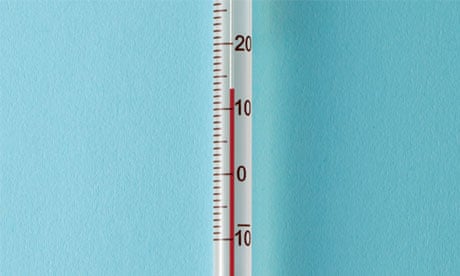
The top ten global warming 'skeptic' arguments answered
Roy Spencer is one of the less than 3% of climate scientists whose research suggests that humans are playing a relatively minimal role in global warming. As one of those rare contrarian climate experts, he's often asked to testify before US Congress and interviewed by media outlets that want to present a 'skeptical' or false balance climate narrative. He's also a rather controversial figure, having made remarks about "global warming Nazis" and said ,
"I view my job a little like a legislator, supported by the taxpayer, to protect the interests of the taxpayer and to minimize the role of government."
In any case, as one of those rare contrarian climate scientists, Spencer is in a good position to present the best arguments against the global warming consensus. Conveniently, he recently did just that on his blog, listing what he considers the "Top Ten Good Skeptical Arguments," throwing in an 11th for good measure. He also conveniently posed each of these arguments as questions; it turns out they're all easy to answer.
1) No Recent Warming. If global warming science is so "settled", why did global warming stop 15 years ago, contrary to all "consensus" predictions?
Quite simply, it hasn't . Even global surface temperatures (which is how Spencer is likely measuring 'global warming', although they only account for about 2% of the Earth's warming ), have warmed about 0.2°C over the past 15 years, according to the best available measurements . More importantly, the planet has continued to accumulate heat at a rate equivalent to 4 Hiroshima atomic bomb detonations per second over the past 15 years.
2) Natural or Manmade? If we don't know how much of recent warming is natural, then how can we know how much is manmade?
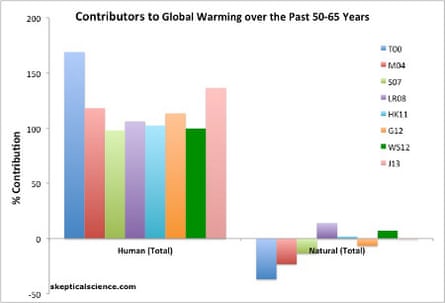
The IPCC stated with 95% confidence that most of the global warming since 1950 is human-caused, with a best estimate that 100% is due to humans over the past 60 years. The IPCC was able to draw this conclusion with such high confidence because that's what the scientific evidence and research clearly and consistently concludes.
3) IPCC Politics and Beliefs. Why does it take a political body (the IPCC) to tell us what scientists "believe"? And when did scientists' "beliefs" translate into proof? And when was scientific truth determined by a vote…especially when those allowed to vote are from the Global Warming Believers Party?
The IPCC merely organizes the world's top climate scientists every 5 to 7 years. It's those scientists who summarize the up-to-date status of the scientific research in their respective fields of expertise. The IPCC report and the 97% expert consensus on human-caused global warming are themselves not proof of anything. They summarize and reflect the scientific evidence – that vast body of evidence is the reason the consensus exists.
4) Climate Models Can't Even Hindcast. How did climate modelers, who already knew the answer, still fail to explain the lack of a significant temperature rise over the last 30+ years? In other words, how to you botch a hindcast?
Global surface temperatures have risen more than 0.5°C over the past 30 years . That rise is significant, both in the statistical and figurative sense. Climate models have accurately reproduced that rise .
5) …But We Should Believe Model Forecasts? Why should we believe model predictions of the future, when they can't even explain the past?
Climate models have accurately reproduced the past, but let's put them aside for a moment. We don't need climate models to project future global warming. We know from past climate change events the planet will warm between about 1.5 and 4.5°C from the increased greenhouse effect of a doubling of atmospheric carbon dioxide (the 'climate sensitivity' ).
In a business-as-usual scenario, atmospheric carbon dioxide levels are expected to surpass 900 ppm by 2100 – that's close to two doublings from the pre-industrial level of 280 ppm. Hence we know that business-as-usual will cause between 2.5 and 7.5°C (most likely 5°C) warming if we stop carbon dioxide levels from rising beyond about 900 ppm. This is based on simple math and what we know about the physics of the climate – no fancy models needed.
6) Modelers Lie About Their "Physics". Why do modelers insist their models are based upon established physics, but then hide the fact that the strong warming their models produce is actually based upon very uncertain "fudge factor" tuning?
Putting aside the accusation that hundreds of climate modelers are all liars – the answer is that their models are indeed based upon well established physics. NASA climate modeler Gavin Schmidt's TED talk on the subject is well worth watching.
Spencer's question likely refers to the uncertain size of the cooling influence of aerosols. However, that is a physical uncertainty. We don't have very good measurements of this effect; unfortunately the rocket carrying NASA's Glory satellite that had instruments to measure the climate effect of aerosols crashed two years ago . Nevertheless, climate models use the available data to account for their influence, and their projections include the associated uncertainties.
7) Is Warming Even Bad? Who decided that a small amount of warming is necessarily a bad thing?
We're headed for about 5°C global surface warming above pre-industrial temperatures by 2100 if we continue on a business-as-usual path. 5°C is the difference between average temperatures now and those during the last ice age. That's not "small" by any stretch of the imagination. As for who decided that amount warming is a bad thing – climate scientists researching the impacts of climate change .
8) Is CO2 Bad? How did carbon dioxide, necessary for life on Earth and only 4 parts in 10,000 of our atmosphere, get rebranded as some sort of dangerous gas?
Carbon dioxide itself is not "bad." Water is also necessary for life. Too much water will kill you. Too much carbon dioxide causes dangerous climate change. Greenhouse gases were determined to be pollutants as defined in the US Clean Air Act . This was a ruling of the (politically conservative) US Supreme Court .
9) Do We Look that Stupid? How do scientists expect to be taken seriously when their "theory" is supported by both floods AND droughts? Too much snow AND too little snow?
This question is a bit like asking, "Do I look fat?". Do you want an honest answer?
The warming of the atmosphere, happening especially at high latitudes , reduces the temperature difference between higher and lower latitudes. This tends to make storms move more slowly . This results in storms dumping more precipitation in localized areas, which causes more flooding in those areas and droughts outside of them. Higher temperatures also increase evaporation, exacerbating droughts and adding more moisture to the air for stronger storms. A climate scientist should understand these concepts.
10) Selective Pseudo-Explanations. How can scientists claim that the Medieval Warm Period (which lasted hundreds of years), was just a regional fluke…yet claim the single-summer (2003) heat wave in Europe had global significance?
There is no contradiction here – a regional event can have global significance, for example via economic impacts. In any case, the Medieval Warm Period was a regional phenomenon and the planet as a whole was cooler than today.
11) (Spinal Tap bonus) Just How Warm is it, Really? Why is it that every subsequent modification/adjustment to the global thermometer data leads to even more warming? What are the chances of that? Either a warmer-still present, or cooling down the past, both of which produce a greater warming trend over time. And none of the adjustments take out a gradual urban heat island (UHI) warming around thermometer sites, which likely exists at virtually all of them — because no one yet knows a good way to do that.
Ironically, most of the adjustments to Spencer's own satellite temperature data set have been in the warming direction , so this question may be an example of psychological projection. Scientists also recently identified a problem in Arctic temperature data analysis that's leading to an incorrect adjustment in the cooling direction , and there have of course been other cooling adjustments in the surface temperature record. The urban heat island effect has also been demonstrated over and over to have no significant influence on the surface temperature record .
Notice a Pattern?
You may have noticed some patterns in these questions. Most are based on false premises and are trivially simple to answer. These 'top ten good skeptic arguments' are frankly not very good or challenging. They also reveal a very one-sided skepticism, although to his credit Spencer did also list 10 'skeptic' arguments that don't hold water . These are glaringly wrong arguments like 'there is no greenhouse effect' and 'CO2 cools the atmosphere,' that some contrarians nevertheless believe. Interestingly, Spencer discusses the science disproving the 10 bad arguments, but there's no scientific discussion supporting his to 'good' arguments.
From reading and answering Spencer's questions, we learn that the basic science behind how we know humans are causing global warming and that it's a problem are quite well-established. There are some remaining uncertainties, like how much warming is being offset by aerosol cooling, but overall we have a very strong understanding of the big picture . For quite a while now we've understood the Earth's climate well enough to know that we can't continue on our current high-risk path .
When will we stop using these trivially wrong contrarian arguments as an excuse for climate inaction? Now that's a tough question to answer.
- Climate crisis
- Climate Consensus - the 97%
- Climate science scepticism and denial
- Climate science
Comments (…)
Most viewed.
The Climate Change Debate: Man vs. Nature

The public discussion on climate change has become so polarized that some scientists don't even acknowledge there is a debate. Climate scientist at NASA's Goddard Institute for Space Studies, Gavin Schmidt, is one of those people. "There aren't 'two sides' to the science, nor to the policy response," Schmidt said. "This implies that the whole thing is just a matter of an opinion – it is not." Another group of scientists would disagree with Schmidt. In June, the Sixth International Conference on Climate Change took place in Washington D.C. It was organized by The Heartland Institute, headquartered in Chicago, and its primary objective is to "dispute the claim that global warming is a crisis." In 2008, the organization published a report titled "Nature, Not Human Activity, Rules the Climate." Its president, Joseph Bast, talking to the journal Nature recently, discussed public opinion on climate change and the ongoing debate. "We've won the public opinion debate, and we've won the political debate as well," Bast said, "but the scientific debate is a source of enormous frustration." The climate change debate, as it discussed in the mainstream media, appears to be divided into two major sides. One side argues that the current global warming is caused by human factors while the other side insists it is occurring because of natural forces. In the latter argument, two natural causes that dominate the conversation are solar changes and changes to the Earth's orbit. [ 10 Surprising Results of Global Warming ] The Sun's Energy Scientists and astronomers have studied the impact of the Sun on the Earth's climate as far back as the early 1800s. Historians have traced the earliest such studies to the research of Sir William Herschel, who tried to link the frequency of sunspots to the price of wheat. His belief was that the number of sunspots would be indicative of the amount of the Sun's energy that is received by the Earth. That energy would affect the amount of wheat produced, which would affect the price.
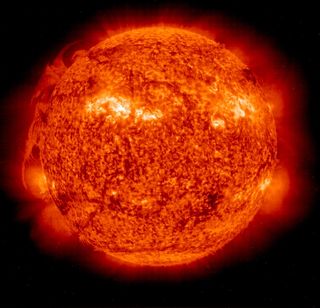
Herschel’s study didn’t make a big impact at the time because he did not have access to historical temperature records to make any useful comparisons. However, there has been a significant amount of research conducted since then to show that variations in the Sun's energy output have an impact on changes in Earth’s climate.
A research study published earlier this year in the Journal of Atmospheric and Solar-Terrestrial Physics provides more evidence of this link between the Sun and the Earth. Through their analysis of historic temperature deviations, geomagnetic activity and the frequency of sunspots, the authors concluded that “the Sun has a significant role to play in the long-term and short-term climate change .” “With more and more data available, it may provoke some thought to further explore the solar influence on Earth's climate with geomagnetic activity acting as a possible link,” said lead author Mufti Sabi ud din, scientist of the Astrophysical Sciences Division at the Bhabha Atomic Research Center in India's Department of Atomic Energy. “It may evoke some response so as to bring to the fore the substantial role of the natural forcing at work on the observed climate variability.” Mufti, however, did note that the evidence of the Sun and other natural forces being the primary cause for climate change is still inadequate. “We do not rule out the natural forcings at work,” he said, “but there isn't enough quantitative evidence to say that natural forcings are the dominant cause of current climate change.” Pointing out the geopolitical sensitivity of the topic itself, Mufti was careful not to rule out anthropogenic effects.
“We have made it amply clear that the anthropogenic origins cannot also be ruled out,” Mufti said. According to Schmidt, while the Sun does have some impact, it is definitively not the reason for current patterns of climate change. “There is an effect,” Schmidt said, “but it is hard to detect in surface records, and is certainly not responsible for recent trends.” Orbital Change Another natural occurrence that has caused major changes in the Earth's climate in the past is shifts in the Earth's orbit. Consider the Sahara desert, for example. There is a wide acceptance among scientists that the Sahara transformed from a fertile grassland to a desert because of a change to the Earth's orbit. This shift in how the Earth circled the Sun affected the amount of sunlight that region of Africa received. The Earth's orbital tilt is said to vary between 22 and 25 degrees roughly every 41,000 years. While a natural event such as this could bring about major changes to the climate, some scientists are warning that there is a possibility for reverse feedback. In other words, instead of an orbital tilt causing climate change, such as the one that took place in the African continent, current changes in climate could end up causing changes in the Earth's axial tilt. In an article published late last year, Astrobiology Magazine reported on such a prediction: “Scientists from NASA's Jet Propulsion Laboratory say that the current melting of ice in Greenland is already causing the tilt to change at a rate of approximately 2.6 centimeters each year. They predict that his change could increase in the years ahead.” The Politics of Climate
Hundreds of scientists around the world have conducted research that show human activities contribute the most to today’s climate change. We are changing the Earth’s atmosphere by emitting huge amounts of greenhouse gases such as carbon dioxide, most of which comes from the burning of fossil fuels. Other human activities include agriculture and changes in land-use patterns. They all work to tip the Earth’s energy balance by trapping more heat. Even scientists who think human activity is the main cause of climate change don't deny that natural changes will cause temperature fluctuations on Earth. However, their argument is that in the current cycle of climate change, the impact caused by man is far greater. But there’s no indication that the two sides of the climate change debate will reach any common ground in the near future on what scientific evidence is showing, or what policy decisions should be adopted. Perhaps the most well-known spokesperson for climate change, former U.S. Vice President Al Gore, recently attracted a lot of media attention for his emotional rant against climate skeptics. When he spoke at the Aspen Institution in Boulder, Colorado in early August, he compared climate skeptics to those who argued that smoking was not harmful to human health in the 1960s. "There are about 10 other memes that are out there, and when you go and talk to any audience about climate, you hear them washing back at you the same crap, over and over and over again,” Gore said. “There is no longer shared reality on an issue like climate, even though the very existence of our civilization is threatened." Although the climate scientists who say that the climate is changing (about 97 percent by some estimates) far outnumber those who don’t, Gore's comments indicate the strength of the message of those who argue against climate change.
The Brookings Institute released a report in April on the public opinion on climate change in the United States and Canada. In a survey of 2,130 people, the report found that there is a progressive decrease in the number of people who think there is “solid evidence of global warming” and an increase in the number who think there is no solid evidence. In the fall of 2008, 17 percent of people did not believe in global warming. In the fall of 2010, that number had increased to 26 percent. Even though the number of climate change believers has decreased, the majority of people still believed that the Earth is undergoing global warming and most of them (61 percent of Americans and 57 percent of Canadians) felt it was a “very serious” problem. Moving On Despite knowing the difference between weather and climate, both climate supporters and opponents, usually in politics and media, often can't refrain from using short-term weather patterns to bolster their respective arguments. Harsh winters are used as evidence of no global warming while scorching summers are used to support the viewpoint of human-caused warming of the Earth. Individual seasonal weather events such as a “snowmageddon” or heat waves cannot be directly attributed to either argument of the climate change debate because such events alone are temporary affects. Climate change, on the other hand, is a long-term problem. However, an increasing frequency of such extreme weather events can be another indication that climate change is in fact a reality. In this complex and seemingly never-ending debate, there is now an increasing number of scientists and other observers who say researchers and policymakers need to move on, to respond to the Earth's reactions to global warming instead of still debating whether or not it is a reality.
Climate change effects nearly every other sector of society. Take, for example, public health. Some of the diseases that impact global populations the most, such as malaria and diarrhea that kill millions each year, are highly sensitive to climatic conditions. Then there is the inequity of these risks. China is now the world’s top emitter of greenhouse gases, but developed countries, primarily the United States, is still mainly responsible for causing climate change after having emitted the most pollution for the longest time. But the populations that suffer the most from climatic changes will be those in developing countries – countries that have contributed the least to climate change and populations who have the least access to resources that could help them deal with the consequences. There are numerous other reports which show the impact of climate change on various other sectors such as agriculture, energy, insurance and even national security. Schmidt expressed the urgency of addressing climate change now. "The consequences of climate change increase, and they increase quite rapidly as the temperatures rise," Schmidt said. "The faster we act, the less bad the peak warming will be. It will take a long time to turn this around." But Schmidt rejects the idea that there is a point of no return. "This idea that there's just one point, I think that makes people complacent now and then it would make people fatalistic afterwards," Schmidt said. "Whatever the situation is, there will be choices that we can make as a society that will make it better in the future or worse. The longer we let it go without doing anything, the worse the consequences will be before it comes back down and we get it back under control, but there's never a point at which there's nothing that can be done. There is an urgency to acting but it's not because there's a point of no return."
Sign up for the Live Science daily newsletter now
Get the world’s most fascinating discoveries delivered straight to your inbox.
This story was provided by Astrobiology Magazine , a web-based publication sponsored by the NASA astrobiology program .
When were sea levels highest?
'Worrisome and even frightening': Ancient ecosystem of Lake Baikal at risk of regime change from warming
Early humans lived on 'Persian plateau' for 20,000 years after leaving Africa, study suggests
Most Popular
By Joe Rao April 03, 2024
By Lloyd Coombes April 03, 2024
By Sharmila Kuthunur April 03, 2024
By Rahul Rao April 03, 2024
By Ben Turner April 02, 2024
By Josh Dinner April 02, 2024
By Sascha Pare April 02, 2024
By Jennifer Nalewicki April 02, 2024
By Emily Cooke April 02, 2024
By Marlowe Starling April 02, 2024
- 2 'You could almost see and smell their world': Remnants of 'Britain's Pompeii' reveal details of life in Bronze Age village
- 3 Hidden chunk of Earth's crust that seeded birth of 'Scandinavia' discovered through ancient river crystals
- 4 Why NASA is launching 3 rockets into the solar eclipse next week
- 5 Do animals really have instincts?
- 2 Nuclear fusion reactor in South Korea runs at 100 million degrees C for a record-breaking 48 seconds
- 3 'It's had 1.1 billion years to accumulate': Helium reservoir in Minnesota has 'mind-bogglingly large' concentrations
- 4 Explosive green 'Mother of Dragons' comet now visible in the Northern Hemisphere

The Effects of Climate Change
The effects of human-caused global warming are happening now, are irreversible for people alive today, and will worsen as long as humans add greenhouse gases to the atmosphere.

- We already see effects scientists predicted, such as the loss of sea ice, melting glaciers and ice sheets, sea level rise, and more intense heat waves.
- Scientists predict global temperature increases from human-made greenhouse gases will continue. Severe weather damage will also increase and intensify.
Earth Will Continue to Warm and the Effects Will Be Profound

Global climate change is not a future problem. Changes to Earth’s climate driven by increased human emissions of heat-trapping greenhouse gases are already having widespread effects on the environment: glaciers and ice sheets are shrinking, river and lake ice is breaking up earlier, plant and animal geographic ranges are shifting, and plants and trees are blooming sooner.
Effects that scientists had long predicted would result from global climate change are now occurring, such as sea ice loss, accelerated sea level rise, and longer, more intense heat waves.
The magnitude and rate of climate change and associated risks depend strongly on near-term mitigation and adaptation actions, and projected adverse impacts and related losses and damages escalate with every increment of global warming.

Intergovernmental Panel on Climate Change
Some changes (such as droughts, wildfires, and extreme rainfall) are happening faster than scientists previously assessed. In fact, according to the Intergovernmental Panel on Climate Change (IPCC) — the United Nations body established to assess the science related to climate change — modern humans have never before seen the observed changes in our global climate, and some of these changes are irreversible over the next hundreds to thousands of years.
Scientists have high confidence that global temperatures will continue to rise for many decades, mainly due to greenhouse gases produced by human activities.
The IPCC’s Sixth Assessment report, published in 2021, found that human emissions of heat-trapping gases have already warmed the climate by nearly 2 degrees Fahrenheit (1.1 degrees Celsius) since 1850-1900. 1 The global average temperature is expected to reach or exceed 1.5 degrees C (about 3 degrees F) within the next few decades. These changes will affect all regions of Earth.
The severity of effects caused by climate change will depend on the path of future human activities. More greenhouse gas emissions will lead to more climate extremes and widespread damaging effects across our planet. However, those future effects depend on the total amount of carbon dioxide we emit. So, if we can reduce emissions, we may avoid some of the worst effects.
The scientific evidence is unequivocal: climate change is a threat to human wellbeing and the health of the planet. Any further delay in concerted global action will miss the brief, rapidly closing window to secure a liveable future.
Here are some of the expected effects of global climate change on the United States, according to the Third and Fourth National Climate Assessment Reports:
Future effects of global climate change in the United States:
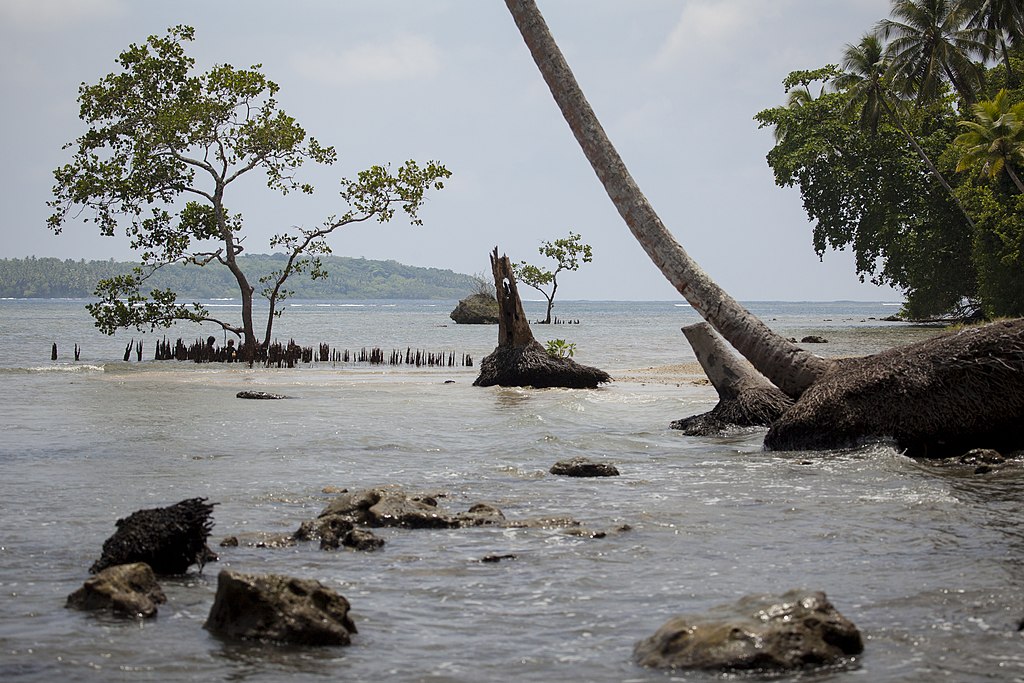
U.S. Sea Level Likely to Rise 1 to 6.6 Feet by 2100
Global sea level has risen about 8 inches (0.2 meters) since reliable record-keeping began in 1880. By 2100, scientists project that it will rise at least another foot (0.3 meters), but possibly as high as 6.6 feet (2 meters) in a high-emissions scenario. Sea level is rising because of added water from melting land ice and the expansion of seawater as it warms. Image credit: Creative Commons Attribution-Share Alike 4.0
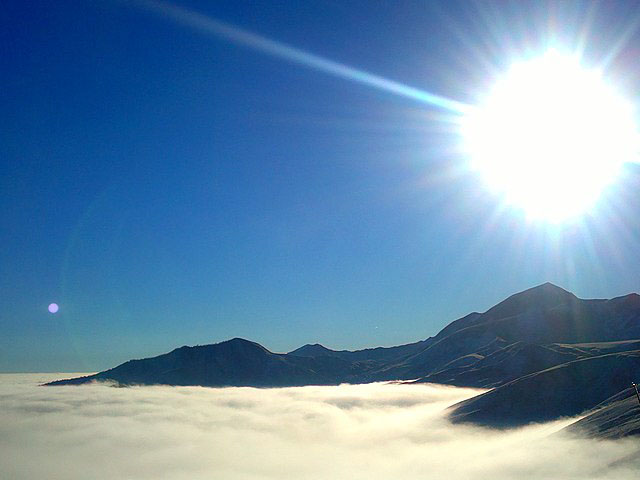
Climate Changes Will Continue Through This Century and Beyond
Global climate is projected to continue warming over this century and beyond. Image credit: Khagani Hasanov, Creative Commons Attribution-Share Alike 3.0
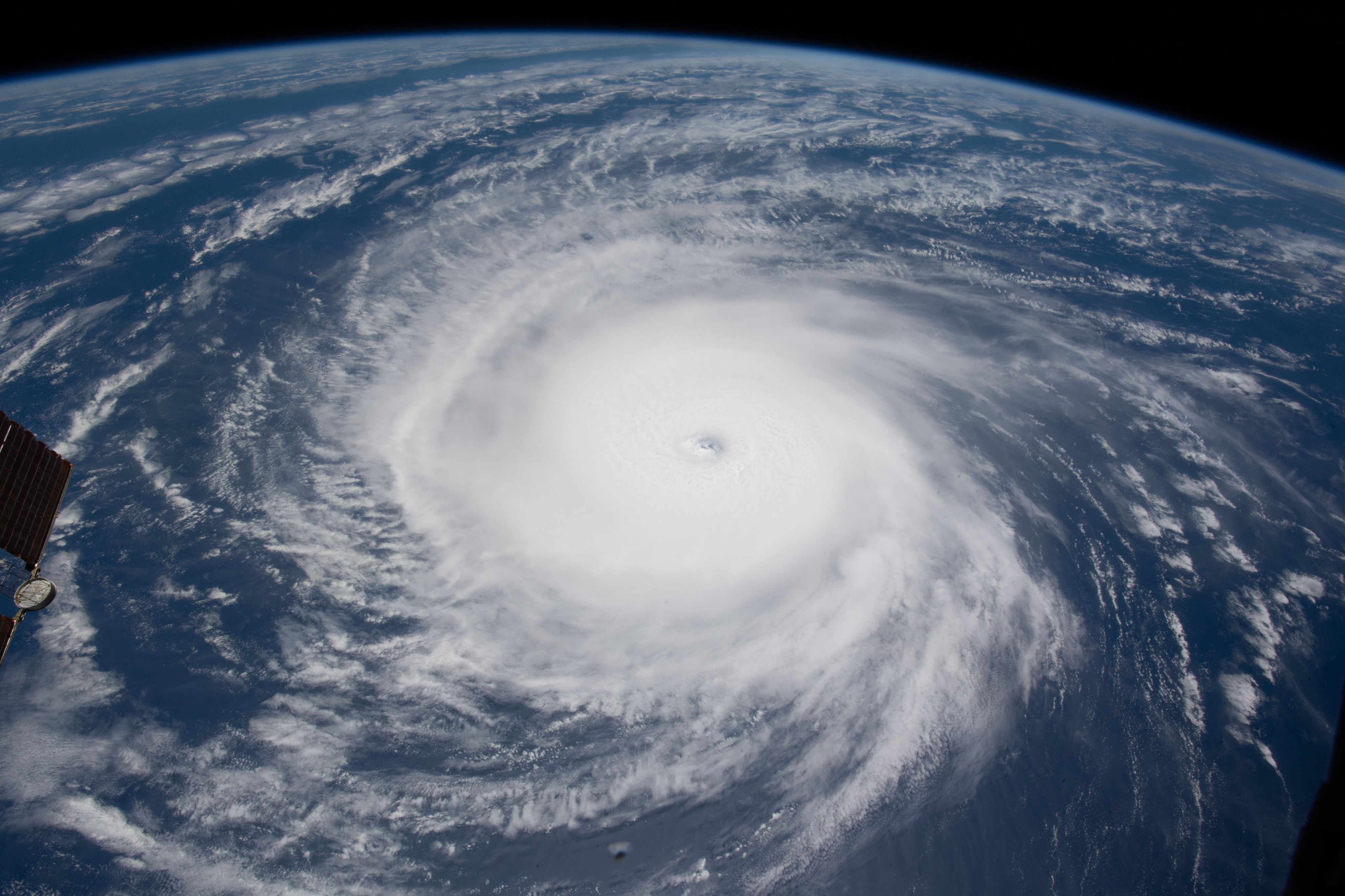
Hurricanes Will Become Stronger and More Intense
Scientists project that hurricane-associated storm intensity and rainfall rates will increase as the climate continues to warm. Image credit: NASA
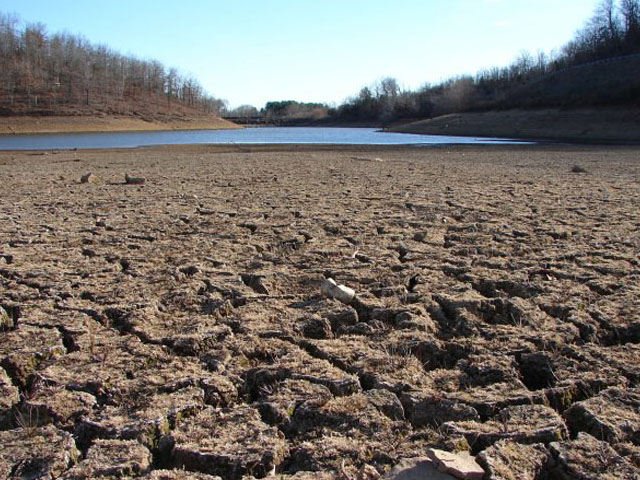
More Droughts and Heat Waves
Droughts in the Southwest and heat waves (periods of abnormally hot weather lasting days to weeks) are projected to become more intense, and cold waves less intense and less frequent. Image credit: NOAA
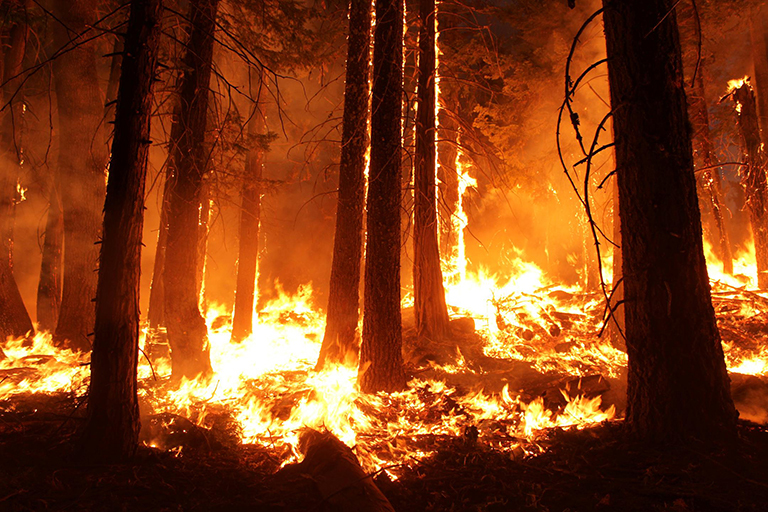
Longer Wildfire Season
Warming temperatures have extended and intensified wildfire season in the West, where long-term drought in the region has heightened the risk of fires. Scientists estimate that human-caused climate change has already doubled the area of forest burned in recent decades. By around 2050, the amount of land consumed by wildfires in Western states is projected to further increase by two to six times. Even in traditionally rainy regions like the Southeast, wildfires are projected to increase by about 30%.
Changes in Precipitation Patterns
Climate change is having an uneven effect on precipitation (rain and snow) in the United States, with some locations experiencing increased precipitation and flooding, while others suffer from drought. On average, more winter and spring precipitation is projected for the northern United States, and less for the Southwest, over this century. Image credit: Marvin Nauman/FEMA
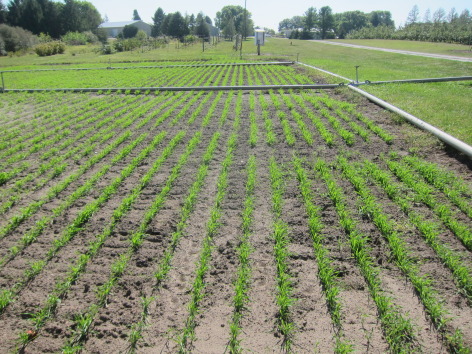
Frost-Free Season (and Growing Season) will Lengthen
The length of the frost-free season, and the corresponding growing season, has been increasing since the 1980s, with the largest increases occurring in the western United States. Across the United States, the growing season is projected to continue to lengthen, which will affect ecosystems and agriculture.
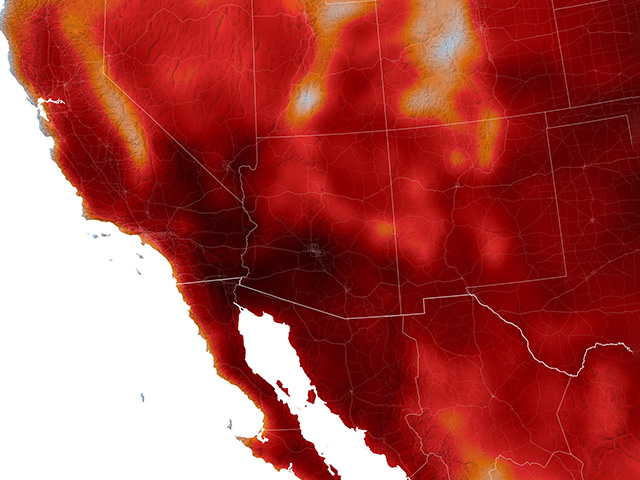
Global Temperatures Will Continue to Rise
Summer of 2023 was Earth's hottest summer on record, 0.41 degrees Fahrenheit (F) (0.23 degrees Celsius (C)) warmer than any other summer in NASA’s record and 2.1 degrees F (1.2 C) warmer than the average summer between 1951 and 1980. Image credit: NASA
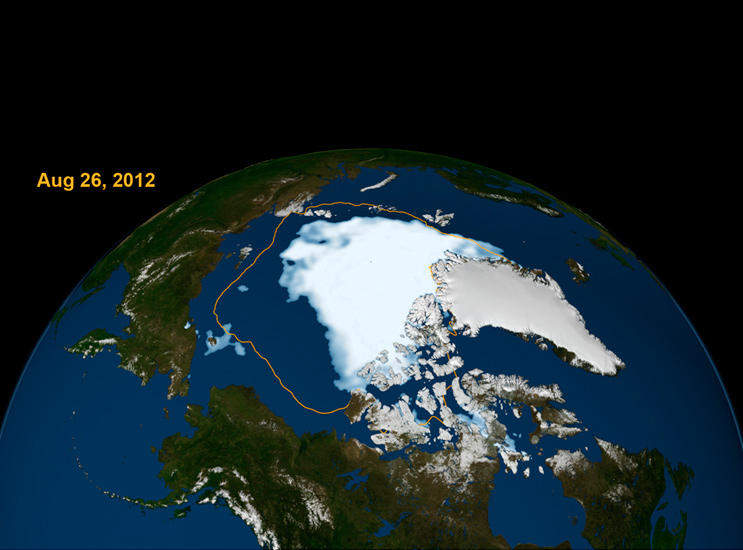
Arctic Is Very Likely to Become Ice-Free
Sea ice cover in the Arctic Ocean is expected to continue decreasing, and the Arctic Ocean will very likely become essentially ice-free in late summer if current projections hold. This change is expected to occur before mid-century.
U.S. Regional Effects
Climate change is bringing different types of challenges to each region of the country. Some of the current and future impacts are summarized below. These findings are from the Third 3 and Fourth 4 National Climate Assessment Reports, released by the U.S. Global Change Research Program .
- Northeast. Heat waves, heavy downpours, and sea level rise pose increasing challenges to many aspects of life in the Northeast. Infrastructure, agriculture, fisheries, and ecosystems will be increasingly compromised. Farmers can explore new crop options, but these adaptations are not cost- or risk-free. Moreover, adaptive capacity , which varies throughout the region, could be overwhelmed by a changing climate. Many states and cities are beginning to incorporate climate change into their planning.
- Northwest. Changes in the timing of peak flows in rivers and streams are reducing water supplies and worsening competing demands for water. Sea level rise, erosion, flooding, risks to infrastructure, and increasing ocean acidity pose major threats. Increasing wildfire incidence and severity, heat waves, insect outbreaks, and tree diseases are causing widespread forest die-off.
- Southeast. Sea level rise poses widespread and continuing threats to the region’s economy and environment. Extreme heat will affect health, energy, agriculture, and more. Decreased water availability will have economic and environmental impacts.
- Midwest. Extreme heat, heavy downpours, and flooding will affect infrastructure, health, agriculture, forestry, transportation, air and water quality, and more. Climate change will also worsen a range of risks to the Great Lakes.
- Southwest. Climate change has caused increased heat, drought, and insect outbreaks. In turn, these changes have made wildfires more numerous and severe. The warming climate has also caused a decline in water supplies, reduced agricultural yields, and triggered heat-related health impacts in cities. In coastal areas, flooding and erosion are additional concerns.
1. IPCC 2021, Climate Change 2021: The Physical Science Basis , the Working Group I contribution to the Sixth Assessment Report, Cambridge University Press, Cambridge, UK.
2. IPCC, 2013: Summary for Policymakers. In: Climate Change 2013: The Physical Science Basis. Contribution of Working Group I to the Fifth Assessment Report of the Intergovernmental Panel on Climate Change [Stocker, T.F., D. Qin, G.-K. Plattner, M. Tignor, S.K. Allen, J. Boschung, A. Nauels, Y. Xia, V. Bex and P.M. Midgley (eds.)]. Cambridge University Press, Cambridge, United Kingdom and New York, NY, USA.
3. USGCRP 2014, Third Climate Assessment .
4. USGCRP 2017, Fourth Climate Assessment .
Related Resources

A Degree of Difference
So, the Earth's average temperature has increased about 2 degrees Fahrenheit during the 20th century. What's the big deal?

What’s the difference between climate change and global warming?
“Global warming” refers to the long-term warming of the planet. “Climate change” encompasses global warming, but refers to the broader range of changes that are happening to our planet, including rising sea levels; shrinking mountain glaciers; accelerating ice melt in Greenland, Antarctica and the Arctic; and shifts in flower/plant blooming times.

Is it too late to prevent climate change?
Humans have caused major climate changes to happen already, and we have set in motion more changes still. However, if we stopped emitting greenhouse gases today, the rise in global temperatures would begin to flatten within a few years. Temperatures would then plateau but remain well-elevated for many, many centuries.
Discover More Topics From NASA
Explore Earth Science

Earth Science in Action

Earth Science Data

Facts About Earth


Climate Change: Evidence and Causes: Update 2020 (2020)
Chapter: conclusion, c onclusion.
This document explains that there are well-understood physical mechanisms by which changes in the amounts of greenhouse gases cause climate changes. It discusses the evidence that the concentrations of these gases in the atmosphere have increased and are still increasing rapidly, that climate change is occurring, and that most of the recent change is almost certainly due to emissions of greenhouse gases caused by human activities. Further climate change is inevitable; if emissions of greenhouse gases continue unabated, future changes will substantially exceed those that have occurred so far. There remains a range of estimates of the magnitude and regional expression of future change, but increases in the extremes of climate that can adversely affect natural ecosystems and human activities and infrastructure are expected.
Citizens and governments can choose among several options (or a mixture of those options) in response to this information: they can change their pattern of energy production and usage in order to limit emissions of greenhouse gases and hence the magnitude of climate changes; they can wait for changes to occur and accept the losses, damage, and suffering that arise; they can adapt to actual and expected changes as much as possible; or they can seek as yet unproven “geoengineering” solutions to counteract some of the climate changes that would otherwise occur. Each of these options has risks, attractions and costs, and what is actually done may be a mixture of these different options. Different nations and communities will vary in their vulnerability and their capacity to adapt. There is an important debate to be had about choices among these options, to decide what is best for each group or nation, and most importantly for the global population as a whole. The options have to be discussed at a global scale because in many cases those communities that are most vulnerable control few of the emissions, either past or future. Our description of the science of climate change, with both its facts and its uncertainties, is offered as a basis to inform that policy debate.
A CKNOWLEDGEMENTS
The following individuals served as the primary writing team for the 2014 and 2020 editions of this document:
- Eric Wolff FRS, (UK lead), University of Cambridge
- Inez Fung (NAS, US lead), University of California, Berkeley
- Brian Hoskins FRS, Grantham Institute for Climate Change
- John F.B. Mitchell FRS, UK Met Office
- Tim Palmer FRS, University of Oxford
- Benjamin Santer (NAS), Lawrence Livermore National Laboratory
- John Shepherd FRS, University of Southampton
- Keith Shine FRS, University of Reading.
- Susan Solomon (NAS), Massachusetts Institute of Technology
- Kevin Trenberth, National Center for Atmospheric Research
- John Walsh, University of Alaska, Fairbanks
- Don Wuebbles, University of Illinois
Staff support for the 2020 revision was provided by Richard Walker, Amanda Purcell, Nancy Huddleston, and Michael Hudson. We offer special thanks to Rebecca Lindsey and NOAA Climate.gov for providing data and figure updates.
The following individuals served as reviewers of the 2014 document in accordance with procedures approved by the Royal Society and the National Academy of Sciences:
- Richard Alley (NAS), Department of Geosciences, Pennsylvania State University
- Alec Broers FRS, Former President of the Royal Academy of Engineering
- Harry Elderfield FRS, Department of Earth Sciences, University of Cambridge
- Joanna Haigh FRS, Professor of Atmospheric Physics, Imperial College London
- Isaac Held (NAS), NOAA Geophysical Fluid Dynamics Laboratory
- John Kutzbach (NAS), Center for Climatic Research, University of Wisconsin
- Jerry Meehl, Senior Scientist, National Center for Atmospheric Research
- John Pendry FRS, Imperial College London
- John Pyle FRS, Department of Chemistry, University of Cambridge
- Gavin Schmidt, NASA Goddard Space Flight Center
- Emily Shuckburgh, British Antarctic Survey
- Gabrielle Walker, Journalist
- Andrew Watson FRS, University of East Anglia
The Support for the 2014 Edition was provided by NAS Endowment Funds. We offer sincere thanks to the Ralph J. and Carol M. Cicerone Endowment for NAS Missions for supporting the production of this 2020 Edition.
F OR FURTHER READING
For more detailed discussion of the topics addressed in this document (including references to the underlying original research), see:
- Intergovernmental Panel on Climate Change (IPCC), 2019: Special Report on the Ocean and Cryosphere in a Changing Climate [ https://www.ipcc.ch/srocc ]
- National Academies of Sciences, Engineering, and Medicine (NASEM), 2019: Negative Emissions Technologies and Reliable Sequestration: A Research Agenda [ https://www.nap.edu/catalog/25259 ]
- Royal Society, 2018: Greenhouse gas removal [ https://raeng.org.uk/greenhousegasremoval ]
- U.S. Global Change Research Program (USGCRP), 2018: Fourth National Climate Assessment Volume II: Impacts, Risks, and Adaptation in the United States [ https://nca2018.globalchange.gov ]
- IPCC, 2018: Global Warming of 1.5°C [ https://www.ipcc.ch/sr15 ]
- USGCRP, 2017: Fourth National Climate Assessment Volume I: Climate Science Special Reports [ https://science2017.globalchange.gov ]
- NASEM, 2016: Attribution of Extreme Weather Events in the Context of Climate Change [ https://www.nap.edu/catalog/21852 ]
- IPCC, 2013: Fifth Assessment Report (AR5) Working Group 1. Climate Change 2013: The Physical Science Basis [ https://www.ipcc.ch/report/ar5/wg1 ]
- NRC, 2013: Abrupt Impacts of Climate Change: Anticipating Surprises [ https://www.nap.edu/catalog/18373 ]
- NRC, 2011: Climate Stabilization Targets: Emissions, Concentrations, and Impacts Over Decades to Millennia [ https://www.nap.edu/catalog/12877 ]
- Royal Society 2010: Climate Change: A Summary of the Science [ https://royalsociety.org/topics-policy/publications/2010/climate-change-summary-science ]
- NRC, 2010: America’s Climate Choices: Advancing the Science of Climate Change [ https://www.nap.edu/catalog/12782 ]
Much of the original data underlying the scientific findings discussed here are available at:
- https://data.ucar.edu/
- https://climatedataguide.ucar.edu
- https://iridl.ldeo.columbia.edu
- https://ess-dive.lbl.gov/
- https://www.ncdc.noaa.gov/
- https://www.esrl.noaa.gov/gmd/ccgg/trends/
- http://scrippsco2.ucsd.edu
- http://hahana.soest.hawaii.edu/hot/

Climate change is one of the defining issues of our time. It is now more certain than ever, based on many lines of evidence, that humans are changing Earth's climate. The Royal Society and the US National Academy of Sciences, with their similar missions to promote the use of science to benefit society and to inform critical policy debates, produced the original Climate Change: Evidence and Causes in 2014. It was written and reviewed by a UK-US team of leading climate scientists. This new edition, prepared by the same author team, has been updated with the most recent climate data and scientific analyses, all of which reinforce our understanding of human-caused climate change.
Scientific information is a vital component for society to make informed decisions about how to reduce the magnitude of climate change and how to adapt to its impacts. This booklet serves as a key reference document for decision makers, policy makers, educators, and others seeking authoritative answers about the current state of climate-change science.
Welcome to OpenBook!
You're looking at OpenBook, NAP.edu's online reading room since 1999. Based on feedback from you, our users, we've made some improvements that make it easier than ever to read thousands of publications on our website.
Do you want to take a quick tour of the OpenBook's features?
Show this book's table of contents , where you can jump to any chapter by name.
...or use these buttons to go back to the previous chapter or skip to the next one.
Jump up to the previous page or down to the next one. Also, you can type in a page number and press Enter to go directly to that page in the book.
Switch between the Original Pages , where you can read the report as it appeared in print, and Text Pages for the web version, where you can highlight and search the text.
To search the entire text of this book, type in your search term here and press Enter .
Share a link to this book page on your preferred social network or via email.
View our suggested citation for this chapter.
Ready to take your reading offline? Click here to buy this book in print or download it as a free PDF, if available.
Get Email Updates
Do you enjoy reading reports from the Academies online for free ? Sign up for email notifications and we'll let you know about new publications in your areas of interest when they're released.

IMAGES
VIDEO
COMMENTS
Argumentative Essay About Climate Change Introduction. The first step is to introduce the topic and provide an overview of the main points you will cover in the essay. This should include a brief description of what climate change is. Furthermore, it should include current research on how humans are contributing to global warming.
Global warming is a process of the Earth's temperature rising, due to radiation from sunlight that is being trapped in the earth by greenhouse gases such as methane and carbon dioxide. The process starts with the greenhouse gases allowing the sunlight to access the Earth; letting the necessary amount in.
Today's climate change is driven by human activities. Scientists know that the warming climate is caused by human activities because: They understand how heat-trapping gases like carbon dioxide work in the atmosphere. They know why those gases are increasing in the atmosphere. They have ruled out other possible explanations.
By Tonya T. Neaves. The climate is changing — the thing is, it isn't just due to humans. Natural forces beyond human control are also gradually affecting our climate. These geophysical forces ...
The scientific consensus. Within the scientific community, there is essentially no disagreement on the causes of climate change. Multiple studies have shown that at least 97 percent of scientists agree that global warming is happening and that human activity is the primary cause. Major scientific assessments also agree.
The scientific consensus that climate change is happening and that it is human-caused is strong. Scientific investigation of global warming began in the 19th century, and by the early 2000s, this research began to coalesce into confidence about the reality, causes, and general range of adverse effects of global warming.
Argument 2: No one really knows why the climate varies The global climate has fluctuated considerably over the Earth's history, either for unknown reasons or because of "internal variability" in the climate system. We do not know enough about the climate system to attribute the present global warming to any specific cause. The Facts
During a recent congressional hearing, Rick Perry, the US energy secretary, remarked that "to stand up and say that 100% of global warming is because of human activity, I think on its face, is just indefensible". However, the science on the human contribution to modern warming is quite clear. Humans emissions and activities have caused ...
Natural causes of climate change. Some amount of climate change can be attributed to natural phenomena. Over the course of Earth's existence, volcanic eruptions, fluctuations in solar radiation ...
Building on two previous studies, a landmark 2013 peer-reviewed study evaluated 10,306 scientists to confirm that over 97 percent climate scientists agree, and over 97 percent of scientific articles find that global warming is real and largely caused by humans.. A 2016 peer-reviewed paper examined existing studies on consensus in climate research, and concluded that the 97 percent estimate is ...
Summary. Subject (s): Earth Science. Topic: Climate Change and Sustainability. Grade/Level: 9-12 (can be adapted to grades 6-8) Objectives: Students will be able to write a scientific argument using evidence and reasoning to support claims. Students will also be able to reflect on the weaknesses in their own arguments in order to improve their ...
Air pollution is detrimental to human health. Malnutrition is linked to a variety of illnesses, including heart disease, cancer, and diabetes. It can also increase the risk of stunting, or ...
Full story. We know this warming is largely caused by human activities because the key role that carbon dioxide plays in maintaining Earth's natural greenhouse effect has been understood since the mid-1800s. Unless it is offset by some equally large cooling influence, more atmospheric carbon dioxide will lead to warmer surface temperatures.
Thu 30 Dec 2010 04.00 EST. Just as the world's most respected scientific bodies have confirmed that world is getting hotter, they have also stated that there is strong evidence that humans are ...
Average global temperatures have increased by 2.2 degrees Fahrenheit, or 1.2 degrees Celsius, since 1880, with the greatest changes happening in the late 20th century. Land areas have warmed more ...
The IPCC stated with 95% confidence that most of the global warming since 1950 is human-caused, with a best estimate that 100% is due to humans over the past 60 years. The IPCC was able to draw ...
A spark of change. "Most human beings have an almost infinite capacity for taking things for granted," says Aldous Huxley in one of his books. He perfectly summarises the biggest cause of the issues the world of today struggles with, the issues that are created by humans' tendency to ignore the consequences of their actions.
Download. Global warming is a great threat to our entire planet and is a condition that was created by man as far back as the Industrialization Era. Unless we begin to make changes to benefit our environment and the Earth now, there will be devastating consequences later. Humans are the most dangerous animals on the planet.
Scientific Consensus. Temperature data showing rapid warming in the past few decades, the latest data going up through 2023. According to NASA, Earth's average surface temperature in 2023 was the warmest on record since recordkeeping began in 1880, continuing a long-term trend of rising global temperatures. On top of that, the 10 most recent ...
Even scientists who think human activity is the main cause of climate change don't deny that natural changes will cause temperature fluctuations on Earth. However, their argument is that in the ...
Global climate change is not a future problem. Changes to Earth's climate driven by increased human emissions of heat-trapping greenhouse gases are already having widespread effects on the environment: glaciers and ice sheets are shrinking, river and lake ice is breaking up earlier, plant and animal geographic ranges are shifting, and plants and trees are blooming sooner.
C ONCLUSION. This document explains that there are well-understood physical mechanisms by which changes in the amounts of greenhouse gases cause climate changes. It discusses the evidence that the concentrations of these gases in the atmosphere have increased and are still increasing rapidly, that climate change is occurring, and that most of ...